- Introduction
- Undergraduate Course
- Graduate Course
- Professors

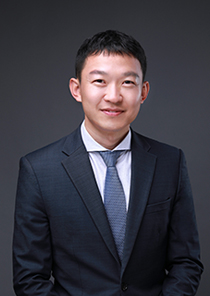
노윤석
- Subject
- Pathophysiology, Preventive Pharmacy
- Phone
- 043-261-2819
- ysroh@chungbuk.ac.kr
- URL
- Go home page
-
Education & Career
- 2000-2008: DVM, College of Veterinary Medicine, Chonbuk National University
- 2008-2011: PhD, Department of Pathology, College of Veterinary Medicine, Chonbuk National University (PI: Bumseok Kim)
- 2012-2015: Postdoctoral Fellow (PI: Ekihiro Seki), Department of Pathology, University of California, San Diego, School of Medicine, CA, USA
- 2015-2016: Postdoctoral Scientist (PI: Ekihiro Seki), Department of Medicine, Cedars-Sinai Medical Center, Los Angeles, CA, USA
- 2016-Present: Assistant Professor, College of Pharmacy, Chungbuk National University
Research Areas
-
Target Discovery and Validation in Non-alcoholic Steatohepatitis (NASH)
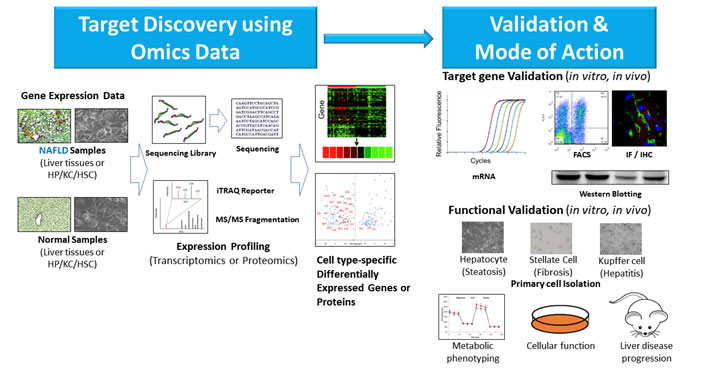
-
Identification of hepatocyte-derived secretome in transition from simple steatosis to NASH

-
Mitochondrial Quality Control as a Therapeutic Target in Fatty Liver and me
tabolic syndrome 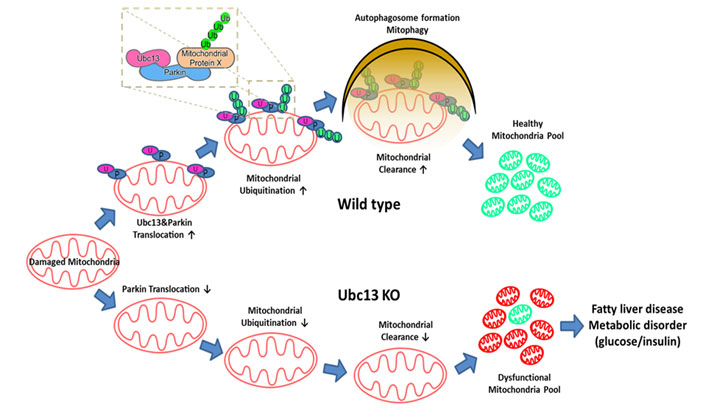
Selected Publications
I. Primary authorships (First author or Corresponding author):
P-1. Hepatology 2014 Jul;60(1):237-49. (IF: 14.079)
P-2. Journal of Clinical Investigation 2014 Aug;124(8):3566-78. (IF: 13.251)
P-3. Gastroenterology 2015 Jan;148(1):252-254. (IF: 20.773)
P-4. American Journal of Pathology 2018 Nov;188(11):2574-2588. (IF: 4.069)
P-5. Antioxidants & Redox Signaling 2019 May; Epub ahead of print (IF: 7.407)
II. Contributed authorships (co-author):
C-1. Nature Communications 2014 Jul 21;5:4451. (IF: 12.353)
C-2. Hepatology 2014 Feb;59(2):483-95. (IF: 14.079)
C-3. Gastroenterology 2013 May;144(5):1042-1054. (IF: 20.773)
C-4. Theranostics. 2018 Aug 7;8(16):4409-4428. (IF: 8.537)
C-5. Science Translational Medicine 2019 Jun; Epub ahead of print (IF: 16.71)

박선이
- Subject
- Clinical Pharmacy
- Phone
- 043-261-2826
- psunny0708@chungbuk.ac.kr
-
Education & Career
- 2007-2011: BS, College of Pharmacy, Dongduk Womens University
- 2011-2015: PhD, College of Pharmacy & Division of Life and Pharmaceutical Sciences, Ewha Womans University
- 2015-2017: Research Fellow, Clinical Research Division, National Institute of Food and Drug Safety Evaluation
- 2017: Senior Researcher, Biometrics, Hanmi Pharmaceutical Co., Ltd., Korea
- 2019-2025: Research professor in College of Pharmacy and Research Institute of Pharmaceutical Sciences, Korea University
- 2025-Present: Assistant professor, College of Pharmacy, Chungbuk National University
Research Areas
-
Pharmacovigilance study

-
Population pharmacokinetic study

-
Clinical nutrition study

-
Pharmacogenomics study

Selected Publications
-
Park, S.; Kim, Y. J.; Lee, G. H., Exploring the risk of hyperhidrosis with tramadol in real-world settings: A pharmacovigilance study. Drug Targets and Therapeutics 2025, 4 (2): 130-135.
-
Park, S.; Kim, M. K.; Park, S. B.; Kim, D. H.; Byun, Y. J.; Choi, S. A., Neurological Adverse Events Associated with the Use of Janus Kinase Inhibitors: A Pharmacovigilance Study ba
sed on Vigiba se. Pharmaceuticals (ba sel) 2025, 18 (3).
-
Lee, G. H.; Kim, Y. J.; Park, S. H.; Park, S.; Lim, S. Y.; Choi, S. A., Application of me
tabolic phase-specific modified nutrition risk in critically ill score: a prospective observational study in critically ill patients. Front Nutr 2024, 11, 1367727.
-
Park, S.; Lee, G. H.; Kim, S.; Kim, S.; Kim, Y.; Choi, S. A., Risk Factors for Respiratory Depression Associated with Tramadol ba
sed on the Global Pharmacovigilance Databa se (Vigiba se). Pharmaceuticals (ba sel) 2024, 17 (2).
-
Park, S.; Kim, Y.; Lee, G. H.; Choi, S. A., A risk of serious anaphylatic reactions to asthma biologics: a pharmacovigilance study ba
sed on a global real-world databa se. Sci Rep 2023, 13 (1), 17607.
-
Park, S.; Park, S. H.; Kim, Y.; Lee, G. H.; Kim, H. S.; Lim, S. Y.; Choi, S. A., Optimal Nutritional Support Strategy ba
sed on the Association between Modified NUTRIC Score and 28-Day Mortality in Critically Ill Patients: A Prospective Study. Nutrients 2023, 15 (11).
-
Park, H. T.; Park, S.; Jung, Y. W.; Choi, S. A., Is Omalizumab Related to Ear and Labyrinth Disorders? A Disproportionality Analysis ba
sed on a Global Pharmacovigilance Databa se. Diagnostics (ba sel) 2022, 12 (10).
-
Park, S.; Park, S. H.; Byun, Y. J.; Choi, S. A., Short communication: Comments on hair disorders associated with dupilumab ba
sed on Vigiba se. PLoS One 2022, 17 (7), e0270906.
-
Park, S.; Lee, J. H.; Park, J. H.; Park, S. H.; Park, S. Y.; Jung, Y. W.; Choi, S. A., Ocular surface disorders associated with the use of dupilumab ba
sed on WHO Vigiba se. Sci Rep 2021, 11 (1), 14293.
-
Kang, M. J.; Park, J. H.; Park, S.; Kim, N. G.; Kim, E. Y.; Yu, Y. M.; Kim, D. Y.; Lee, J. Y.; Shin, W. G.; Choi, S. A., Community pharmacists' knowledge, perceptions, and practices about topical corticosteroid counseling: A real-world cross-sectional survey and focus group discussions in Korea. PLoS One 2020, 15 (7), e0236797.
-
Park, J. H.; Park, S.; Choi, S. A., Incidence and risk factors of spinal epidural hemorrhage after spine surgery: a cross-sectional retrospective analysis of a national databa
se. BMC Musculoskelet Disord 2020, 21 (1), 324.
-
Sung, J. W.; Yun, H. Y.; Park, S.; Kim, Y. J.; Yee, J.; Lee, K. E.; Song, B.; Chung, J. E.; Gwak, H. S., Population Pharmacokinetics of Sulindac and Genetic Polymorphisms of FMO3 and AOX1 in Women with Preterm Labor. Pharm Res 2020, 37 (3), 44.
-
Park, S.; Hyun, Y. J.; Kim, Y. R.; Lee, J. H.; Ryu, S.; Kim, J. M.; Oh, W. Y.; Na, H. S.; Lee, J. G.; Seo, D. W.; Hwang, I. Y.; Park, Z.; Jang, I. J.; Oh, J.; Choi, S. E., Effects of CYP2C19 Genetic Polymorphisms on PK/PD Responses of Omeprazole in Korean Healthy Volunteers. J Korean Med Sci 2017, 32 (5), 729-736.
-
Lee, K. E.; Chang, B. C.; Park, S.; Gwak, H. S., Effects of single nucleotide polymorphisms in c-Myc on stable warfarin doses in patients with cardiac valve replacements. Pharmacogenomics 2015, 16 (10), 1101-8.
-
Park, J. H.; Park, S.; Kim, J. Y.; Kim, J. H.; Gwak, H. S., Comparative effectiveness between dipeptidylpeptidase-4 inhibitors and sulfonylureas in combination with metformin in Type 2 diabetes melitus patients. Korean Journal of Clinical Pharmacy 2015, 25 (2), 74-79.
-
Park, J. Y.; Lee, N. R.; Lee, K. E.; Park, S.; Kim, Y. J.; Gwak, H. S., Effects of β2-adrenergic receptor gene polymorphisms on ritodrine therapy in pregnant women with preterm labor: prospective follow-up study. Int J Mol Sci 2014, 15 (7), 12885-94.
-
Park, S.; Lee, N. R.; Lee, K. E.; Park, J. Y.; Kim, Y. J.; Gwak, H. S., Effects of single-nucleotide polymorphisms of FMO3 and FMO6 genes on pharmacokinetic characteristics of sulindac sulfide in premature labor. Drug me
tab Dispos 2014, 42 (1), 40-3.
Education & Career
- -
Patents
-Patents
-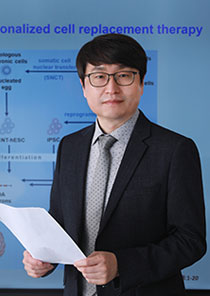
손동주
- Subject
- Anatomy & Physiology I· II
- Phone
- 043-261-2822
- sondj1@chungbuk.ac.kr
-
Education & Career:
- 1992-1999: B.S. in Food Science & Nutrition, Soonchunhyang University
- 1999-2001: M.S. in Food Science & Nutrition, Soonchunhyang University
- 2001-2004: Ph.D. in Molecular Nutrition, Soonchunhyang University
- 2004-2007: Research Professor/Postdoctoral Fellow, College of Pharmacy and School of Veterinary Medicine, Chungbuk National University
- 2007-2008: Postdoctoral Fellow, Department of Pathology, College of Medicine, University of Iowa, Iowa City, USA
- 2008-2013: Instructor/Postdoctoral Fellow, Department of Biomedical Engineering and Division of Cardiology, School of Medicine, Emory University and Georgia Institute of Technology, Atlanta, Georgia, USA
- 2014-2015: Research Professor, Department of Applied Bioscience, College of Agriculture and Life Science, Kyungpook Nationation University
- 2015-2017: Research Professor, MRC, College of Pharmacy, Chungbuk National University
- 2017-2019: Chief Technology Officer, Life Science R&D Center, NovaKmed Co. Ltd.
- 2019-present: Assistant Professor, College of Pharmacy, Chungbuk National University
Research Areas
-
Exploring the role of blood flow shear stress in endothelial cell physiology and vascular diseases
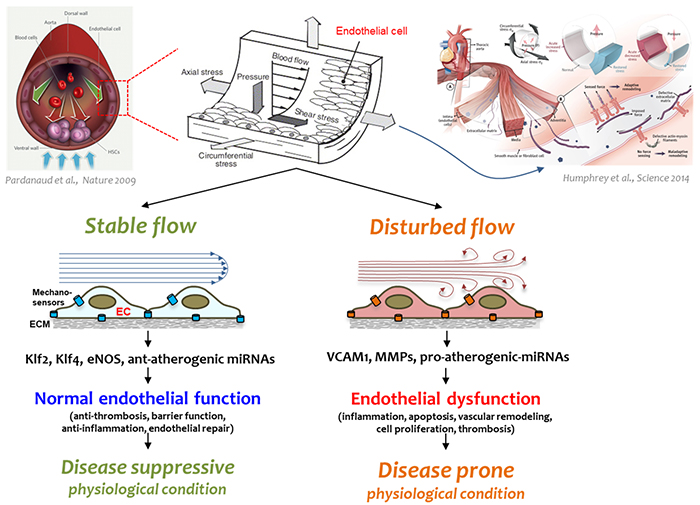
-
Development of novel animal model for endothelial dysfunction and vascular diseases
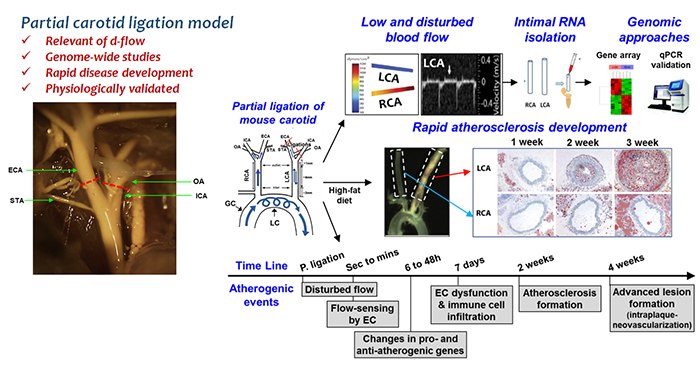
-
Identification of flow-mechanosensitive genes and physiological validation
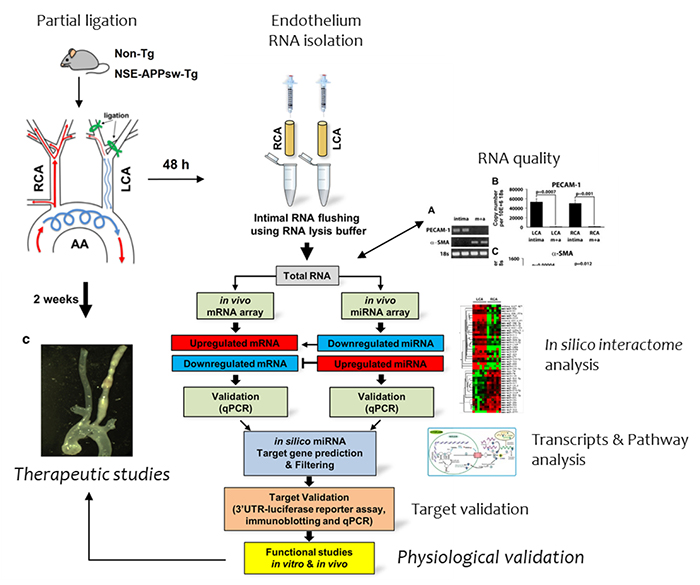
Selected Publications
- FlexPro MD®, a Combination of Krill Oil, Astaxanthin and Hyaluronic Acid, Reduces Pain Behavior and Inhibits Inflammatory Response in Monosodium Iodoacetate-Induced Osteoarthritis in Rats. Park MH, Jung JC, Hill S, Cartwright E, Dohnalek MH, Yu M, Jun HJ, Han SB, Hong JT, Son DJ. Nutrients. 2020 Mar 30;12(4). pii: E956.
- Anxiolytic-like effects of the ethanol extract of Magnolia obovata leaves through its effects on GABA-benzodiazepine receptor and neuroinflammation. Ham HJ, Lee YS, Yun J, Han SB, Son DJ, Hong JT. Behav Brain Res. 2020 Apr 6;383:112518.
- Wheat Extract Oil (WEO) Attenuates UVB-Induced Photoaging via Collagen Synthesis in Human Keratinocytes and Hairless Mice. Son DJ, Jung JC, Choi YM, Ryu HY, Lee S, Davis BA. Nutrients. 2020 Jan 22;12(2). pii: E300.
- Fermented Korean Red Ginseng Extract Enriched in Rd and Rg3 Protects against Non-Alcoholic Fatty Liver Disease through Regulation of mTORC1. Choi SY, Park JS, Shon CH, Lee CY, Ryu JM, Son DJ, Hwang BY, Yoo HS, Cho YC, Lee J, Kim JW, Roh YS. Nutrients. 2019 Dec 4;11(12). pii: E2963.
-
Suppression of me
tastasis through inhibition of chitinase 3-like 1 ex pression by miR-125a-3p-mediated up-regulation of USF1. Kim KC, Yun J, Son DJ, Kim JY, Jung JK, Choi JS, Kim YR, Song JK, Kim SY, Kang SK, Shin DH, Roh YS, Han SB, Hong JT. Theranostics. 2018 Aug 7;8(16):4409-4428 - PRDX6 Inhibits Neurogenesis through Downregulation of WDFY1-Mediated TLR4 Signal. Yeo IJ, Park MH, Son DJ, Kim JY, Nam KT, Hyun BK, Kim SY, Jung MH, Song MJ, Chun HO, Lee TH, Han SB, Hong JT. Mol Neurobiol. 2019 May;56(5):3132-3144.
- Piperlongumine Improves Lipopolysaccharide-Induced Amyloidogenesis by Suppressing NF-KappaB Pathway. Gu SM, Lee HP, Ham YW, Son DJ, Kim HY, Oh KW, Han SB, Yun J, Hong JT. Neuromolecular Med. 2018 Sep;20(3):312-327.
-
IL-32 gamma reduces lung tumor development through upregulation of TIMP-3 overex
pression and hypomethylation. Yun J, Park MH, Son DJ, Nam KT, Moon DB, Ju JH, Hwang OK, Choi JS, Kim TH, Jung YS, Hwang DY, Han SB, Yoon DY, Hong JT. Cell Death Dis. 2018 Feb 21;9(3):306. - Atherosclerosis is exacerbated by chitinase-3-like-1 in amyloid precursor protein transgenic mice. Jung YY, Kim KC, Park MH, Seo Y, Park H, Park MH, Chang J, Hwang DY, Han SB, Kim S, Son DJ, Hong JT. Theranostics. 2018 Jan 1;8(3):749-766.
- Antarctic Krill Oil Diet Protects against Lipopolysaccharide-Induced Oxidative Stress, Neuroinflammation and Cognitive Impairment. Choi JY, Jang JS, Son DJ, Im HS, Kim JY, Park JE, Choi WR, Han SB, Hong JT. Int J Mol Sci. 2017 Nov 28;18(12). pii: E2554.
- MMPP Attenuates Non-Small Cell Lung Cancer Growth by Inhibiting the STAT3 DNA-Binding Activity via Direct Binding to the STAT3 DNA-Binding Domain. Son DJ, Zheng J, Jung YY, Hwang CJ, Lee HP, Woo JR, Baek SY, Ham YW, Kang MW, Shong M, Kweon GR, Song MJ, Jung JK, Han SB, Kim BY, Yoon DY, Choi BY, Hong JT. Theranostics. 2017 Oct 16;7(18):4632-4642.
- Interleukin-32α Inhibits Endothelial Inflammation, Vascular Smooth Muscle Cell Activation, and Atherosclerosis by Upregulating Timp3 and Reck through suppressing microRNA-205 Biogenesis. Son DJ, Jung YY, Seo YS, Park H, Lee DH, Kim S, Roh YS, Han SB, Yoon DY, Hong JT. Theranostics. 2017 Jun 1;7(8):2186-2203.
- Parkin Knockout Inhibits Neuronal Development via Regulation of Proteasomal Degradation of p21. Park MH, Lee HJ, Lee HL, Son DJ, Ju JH, Hyun BK, Jung SH, Song JK, Lee DH, Hwang CJ, Han SB, Kim S, Hong JT. Theranostics. 2017 May 12;7(7):2033-2045.
- Activated Natural Killer Cells Mediate the Suppressive Effect of Interleukin-4 on Tumor Development via STAT6 Activation in an Atopic Condition Melanoma Model. Son DJ, Jung YY, Park MH, Lee HL, Song MJ, Yoo HS, Hwang DY, Han SB, Hong JT. Neoplasia. 2017 Jul;19(7):537-548.
- Loss of Parkin reduces inflammatory arthritis by inhibiting p53 degradation. Jung YY, Son DJ, Lee HL, Kim DH, Song MJ, Ham YW, Kim Y, Han SB, Park MH, Hong JT. Redox Biol. 2017 Aug;12:666-673.
- (E)-2-methoxy-4-(3-(4-methoxyphenyl)prop-1-en-1-yl)phenol suppresses ovarian cancer cell growth via inhibition of ERK and STAT3. Zheng J, Son DJ, Lee HL, Lee HP, Kim TH, Joo JH, Ham YW, Kim WJ, Jung JK, Han SB, Hong JT. Mol Carcinog. 2017 Sep;56(9):2003-2013.
- Interleukin 32, inflammation and cancer. Hong JT, Son DJ, Lee CK, Yoon DY, Lee DH, Park MH. Pharmacol Ther. 2017 Jun;174:127-137.
- Inhibitory effect of punicalagin on lipopolysaccharide-induced neuroinflammation, oxidative stress and memory impairment via inhibition of nuclear factor-kappaB. Kim YE, Hwang CJ, Lee HP, Kim CS, Son DJ, Ham YW, Hellström M, Han SB, Kim HS, Park EK, Hong JT. Neuropharmacology. 2017 May 1;117:21-32.
- Parkin deficiency exacerbate ethanol-induced dopaminergic neurodegeneration by P38 pathway dependent inhibition of autophagy and mitochondrial function. Hwang CJ, Kim YE, Son DJ, Park MH, Choi DY, Park PH, Hellström M, Han SB, Oh KW, Park EK, Hong JT. Redox Biol. 2017 Apr;11:456-468.
- Piperlongumine attenuates experimental autoimmune encephalomyelitis through inhibition of NF-kappaB activity. Gu SM, Yun J, Son DJ, Kim HY, Nam KT, Kim HD, Choi MG, Choi JS, Kim YM, Han SB, Hong JT. Free Radic Biol Med. 2017 Feb;103:133-145.
- Enhanced dopaminergic neurotoxicity mediated by MPTP in IL-32β transgenic mice. Jung YY, Katila N, Neupane S, Shadfar S, Ojha U, Bhurtel S, Srivastav S, Son DJ, Park PH, Yoon DY, Hong JT, Choi DY. Neurochem Int. 2017 Jan;102:79-88.
-
Novel synthetic (E)-2-methoxy-4-(3-(4-methoxyphenyl) prop-1-en-1-yl) phenol inhibits arthritis by targeting signal transducer and activator of transc
ription 3. Son DJ, Kim DH, Nah SS, Park MH, Lee HP, Han SB, Venkatareddy U, Gann B, Rodriguez K, Burt SR, Ham YW, Jung YY, Hong JT. Sci Rep. 2016 Nov 15;6:36852. - Epothilones Suppress Neointimal Thickening in the Rat Carotid Balloon-Injury Model by Inducing Vascular Smooth Muscle Cell Apoptosis through p53-Dependent Signaling Pathway. Son DJ, Jung JC, Hong JT. PLoS One. 2016 May 24;11(5):e0155859.
- Piperlongumine inhibits lung tumor growth via inhibition of nuclear factor kappa B signaling pathway. Zheng J, Son DJ, Gu SM, Woo JR, Ham YW, Lee HP, Kim WJ, Jung JK, Hong JT. Sci Rep. 2016 May 20;6:26357.
- Glutathione peroxidase 1 deficiency attenuates concanavalin A-induced hepatic injury by modulation of T-cell activation. Lee DH, Son DJ, Park MH, Yoon DY, Han SB, Hong JT. Cell Death Dis. 2016 Apr 28;7:e2208.
- Synergistic inhibitory effect of cetuximab and tectochrysin on human colon cancer cell growth via inhibition of EGFR signal. Park MH, Hong JE, Hwang CJ, Choi M, Choi JS, An YJ, Son DJ, Hong JT. Arch Pharm Res. 2016 May;39(5):721-9.
- Effect of Ixeris dentata Nakai Extract on Nitric Oxide Production and Prostaglandin E2 Generation in LPS-stimulated RAW264.7 Cells. Jung YY, Hong JT, Han SB, Park YH, Son DJ. Immune Netw. 2015 Dec;15(6):325-30.
- Synergistic Inhibitory Effects of Cetuximab and Cisplatin on Human Colon Cancer Cell Growth via Inhibition of the ERK-Dependent EGF Receptor Signaling Pathway. Son DJ, Hong JE, Ban JO, Park JH, Lee HL, Gu SM, Hwang JY, Jung MH, Lee DW, Han SB, Hong JT. Biomed Res Int. 2015;2015:397563.
- Multifunctional Nanoparticles Facilitate Molecular Targeting and miRNA Delivery to Inhibit Atherosclerosis in ApoE(-/-) Mice. Kheirolomoom A, Kim CW, Seo JW, Kumar S, Son DJ, Gagnon MK, Ingham ES, Ferrara KW, Jo H. ACS Nano. 2015 Sep 22;9(9):8885-97.
- Anti-Diabetic and Hepato-Renal Protective Effects of Ziyuglycoside II Methyl Ester in Type 2 Diabetic Mice. Son DJ, Hwang SY, Kim MH, Park UK, Kim BS. Nutrients. 2015 Jul 7;7(7):5469-83.
- Bee venom ameliorates lipopolysaccharide-induced memory loss by preventing NF-kappaB pathway. Gu SM, Park MH, Hwang CJ, Song HS, Lee US, Han SB, Oh KW, Ham YW, Song MJ, Son DJ, Hong JT. J Neuroinflammation. 2015 Jun 26;12:124.
- Disturbed flow enhances inflammatory signaling and atherogenesis by increasing thioredoxin-1 level in endothelial cell nuclei. Go YM, Son DJ, Park H, Orr M, Hao L, Takabe W, Kumar S, Kang DW, Kim CW, Jo H, Jones DP. PLoS One. 2014 Sep 29;9(9):e108346.
- Piperine inhibits the activities of platelet cytosolic phospholipase A2 and thromboxane A2 synthase without affecting cyclooxygenase-1 activity: different mechanisms of action are involved in the inhibition of platelet aggregation and macrophage inflammatory response. Son DJ, Akiba S, Hong JT, Yun YP, Hwang SY, Park YH, Lee SE. Nutrients. 2014 Aug 22;6(8):3336-52.
- Bioassay-guided isolation and identification of anti-platelet-active compounds from the root of Ashitaba (Angelica keiskei Koidz.). Son DJ, Park YO, Yu C, Lee SE, Park YH. Nat Prod Res. 2014;28(24):2312-6.
-
Flow-dependent epigenetic DNA methylation regulates endothelial gene ex
pression and atherosclerosis. Dunn J, Qiu H, Kim S, Jjingo D, Hoffman R, Kim CW, Jang I, Son DJ, Kim D, Pan C, Fan Y, Jordan IK, Jo H. J Clin Invest. 2014 Jul;124(7):3187-99. - Prevention of abdominal aortic aneurysm by anti-microRNA-712 or anti-microRNA-205 in angiotensin II-infused mice. Kim CW, Kumar S, Son DJ, Jang IH, Griendling KK, Jo H. Arterioscler Thromb Vasc Biol. 2014 Jul;34(7):1412-21.
-
Flow-dependent regulation of genome-wide mRNA and microRNA ex
pression in endothelial cells in vivo. Kumar S, Kim CW, Son DJ, Ni CW, Jo H. Sci Data. 2014 Oct 28;1:140039. - The atypical mechanosensitive microRNA-712 derived from pre-ribosomal RNA induces endothelial inflammation and atherosclerosis. Son DJ, Kumar S, Takabe W, Kim CW, Ni CW, Alberts-Grill N, Jang IH, Kim S, Kim W, Won Kang S, Baker AH, Woong Seo J, Ferrara KW, Jo H. Nat Commun. 2013;4:3000.
- Piperlongumine inhibits LMP1/MYC-dependent mouse B-lymphoma cells. Han SS, Tompkins VS, Son DJ, Kamberos NL, Stunz LL, Halwani A, Bishop GA, Janz S. Biochem Biophys Res Commun. 2013 Jul 12;436(4):660-5.
- Anti-inflammatory and antiatherogenic role of BMP receptor II in endothelial cells. Kim CW, Song H, Kumar S, Nam D, Kwon HS, Chang KH, Son DJ, Kang DW, Brodie SA, Weiss D, Vega JD, Alberts-Grill N, Griendling K, Taylor WR, Jo H. Arterioscler Thromb Vasc Biol. 2013 Jun;33(6):1350-9.
- Piperlongumine inhibits atherosclerotic plaque formation and vascular smooth muscle cell proliferation by suppressing PDGF receptor signaling. Son DJ, Kim SY, Han SS, Kim CW, Kumar S, Park BS, Lee SE, Yun YP, Jo H, Park YH. Biochem Biophys Res Commun. 2012 Oct 19;427(2):349-54.
- 8-Hydroxy-2-deoxyguanosine prevents plaque formation and inhibits vascular smooth muscle cell activation through Rac1 inactivation. Huh JY, Son DJ, Lee Y, Lee J, Kim B, Lee HM, Jo H, Choi S, Ha H, Chung MH. Free Radic Biol Med. 2012 Jul 1;53(1):109-21.
- Dynamic immune cell accumulation during flow-induced atherogenesis in mouse carotid artery: an expanded flow cytometry method. Alberts-Grill N, Rezvan A, Son DJ, Qiu H, Kim CW, Kemp ML, Weyand CM, Jo H. Arterioscler Thromb Vasc Biol. 2012 Mar;32(3):623-32.
- Discovery of novel mechanosensitive genes in vivo using mouse carotid artery endothelium exposed to disturbed flow. Ni CW, Qiu H, Rezvan A, Kwon K, Nam D, Son DJ, Visvader JE, Jo H. Blood. 2010 Oct 14;116(15):e66-73.
Patents
- Methods and compositions for managing vascular conditions, Application No. 61/916,449(US)
- Use of inhibitors of microRNA-miR-712/miR-205 to treat cardiovascular diseases and cancer, Application No. 61/904,026(US)
- Use of inhibitors of microRNA-712 to treat atherosclerosis, Application No. 61/552,205 (US)
- Composition for preventing or treating fatty liver disease comprising solid phase fermented red ginseng extract by cordyceps, Application No. 10-2019-0020474 (KR)
- Pharmaceutical composition comprising epothilone B for the treating and preventing vascular restenosis, Registration No. 10-0860326 (KR)
- Pharmaceutical composition comprising cinnamaldehyde derivatives for the treating and preventing inflammatory disease, Registration No. 10-0676761 (KR)
- Inhibitor of nuclear factor-kappa B, Registration No. 10-0668229 (KR)

송난
- Subject
- Application of artificial intelligence in pharmacy, Bio bigdata in healthcare
- Phone
- 043-261-1485
- nan.song@chungbuk.ac.kr
- URL
- Go home page
-
Education & Career
- 2006-2010: BS, College of Pharmacy, Wonkwang University, Korea
- 2010-2012: MS, Department of Molecular Medicine and Biopharmaceutical Science, Graduate School of Convergence Science and Technology, Seoul National University, Korea
- 2012-2015: PhD, Cancer Research Institute, Seoul National University, Korea
- 2010-2012: Hospital Pharmacist, Seoul National University Hospital, Korea
- 2015: Hospital Pharmacist, Korea University Anam Hospital, Korea
- 2015-2019: Research Assistant Professor, Cancer Research Institute, Seoul National University, Korea
- 2019-2021: Postdoctoral Research Associate, Department of Epidemiology and Cancer Control, St. Jude Children’s Research Hospital, USA
- 2021-present: Assistant Professor, College of Pharmacy, Chungbuk National University, Korea
Research Areas
-
Big data-driven biomarker discovery for
precision medicine and drug target identification
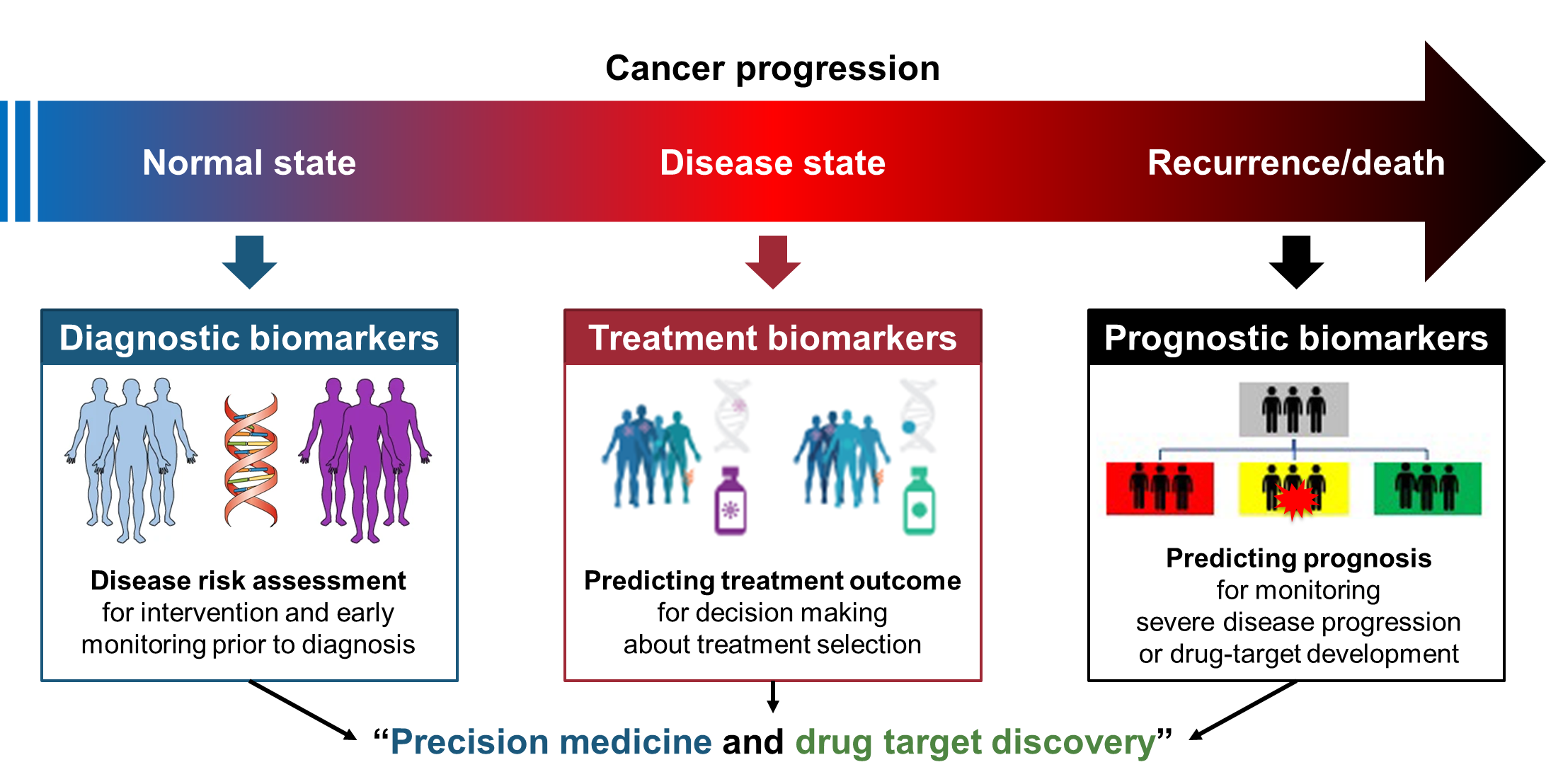
-
Genetic/epigenetic mediation effects
on long-term treatment outcome
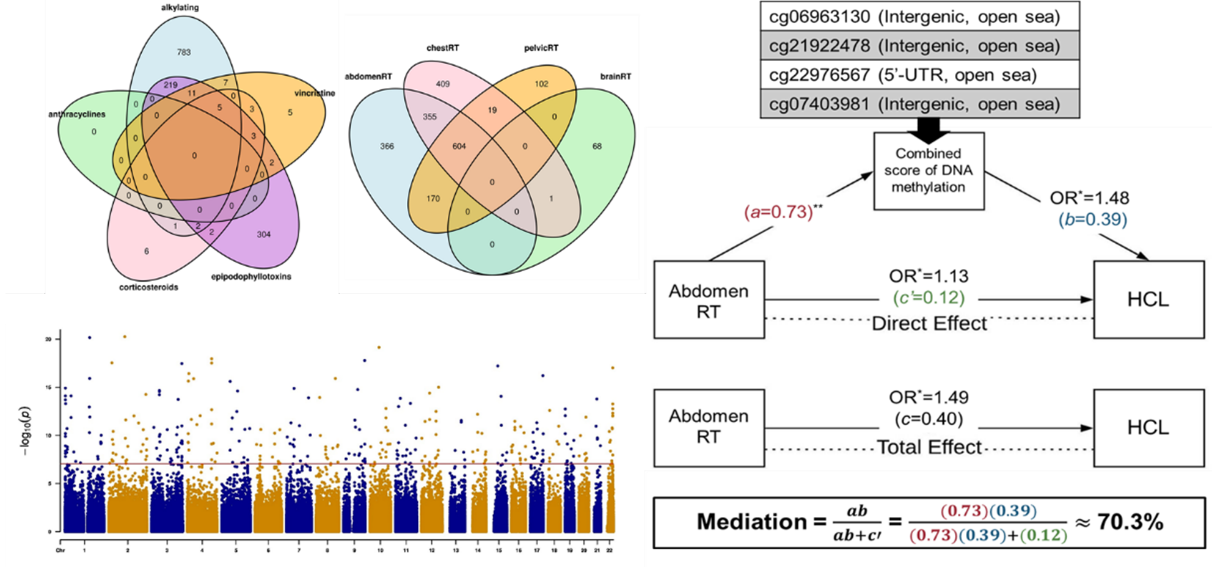
-
Risk prediction and classification
using multi-omics data
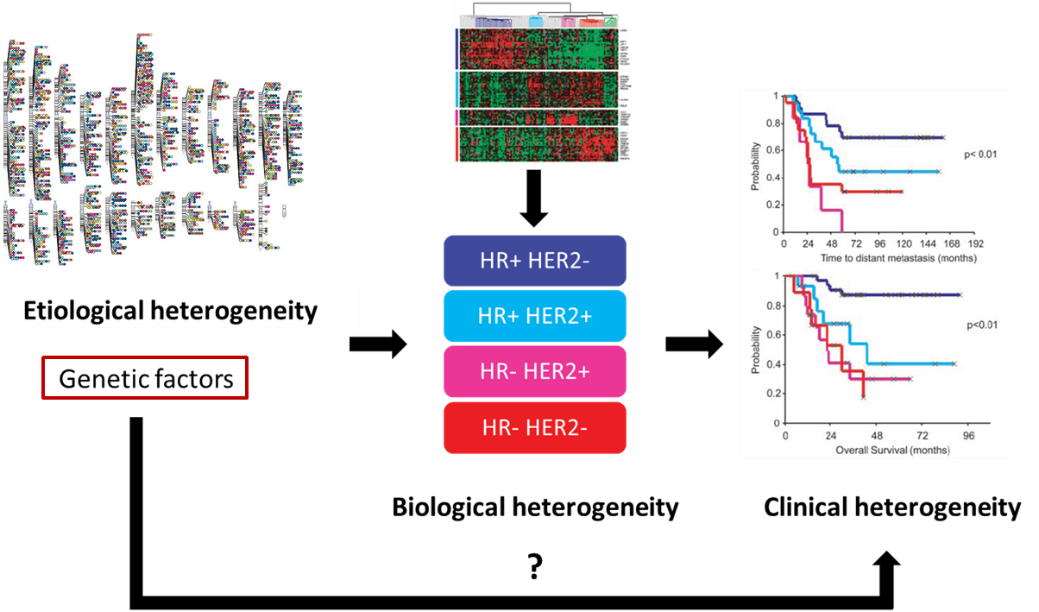
Selected Publications
- Song N, Liu Q, Wilson CL, Sapkota Y, Ehrhardt MJ, Gibson TM, Morton LM, Chanock SJ, Neglia JP, Arnold MA, Michael JR, Gout AM, Mulder HL, Easton J, Bhatia S, Armstrong GT, Zhang J, Delaney A, Hudson MM, Robison LL, Yasui Y, Wang Z. Polygenic Risk Score Improves Risk Stratification and Prediction of Subsequent Thyroid Cancer after Childhood Cancer. Cancer Epidemiol Biomarkers Prev. 2021 Aug 31 [Epub ahead of print]
-
Park J, Choi JY, Choi J, Chung S, Song N, Park SK, Han W, Noh DY, Ahn SH, Lee JW, Kim MK, Jee SH, Wen W, Bolla MK, Wang Q, Dennis J, Michailidou K, Shah M, Conroy DM, Harrington PA, Mayes R, Czene K, Hall P, Teras LR, Patel AV, Couch FJ, Olson JE, Sawyer EJ, Roylance R, Bojesen SE, Flyger H, Lambrechts D, Baten A, Matsuo K, Ito H, Guénel P, Truong T, Keeman R, Schmidt MK, Wu AH, Tseng CC, Cox A, Cross SS, Andrulis IL, Hopper JL, Southey MC, Wu PE, Shen CY, Fasching PA, Ekici AB, Muir K, Lophatananon A, Brenner H, Arndt V, Jones ME, SwerdlowAJ, Hoppe R, Ko YD, Hartman M, Li J, Mannermaa A, Hartikainen JM, Benitez J, González-Neira A, Haiman CA, Dörk T, Bogdanova NV, Teo SH, Taib NAM, Fletcher O, Johnson N, Grip M, Winqvist R, Blomqvist C, Nevanlinna H, Lindblom A, Wendt C, Kristensen VN, Tollenaar RAEM, Heemskerk-Gerritsen BAM, Radice P, Bonanni B, Hamann U, Manoochehri M, Lacey JV, Martinez ME, Dunning AM, Pharoah PDP, Easton DF, Yoo KY, Kang D, kConFab Investigators kConFab Investigators, NBCS Collaborators NBCS Collaborators. Gene-Environment Interactions Relevant to Estrogen and Risk of Breast Cancer: Can Gene-Environment Interactions Be Detected Only among Candidate SNPs from Genome-Wide Association Studies? Cancers (ba
sel). 2021 May 14;13(10). - Qin N*, Li Z*, Song N*, Wilson CL, Easton J, Mulder H, Plyler E, Neale G, Walker E, Zhou X, Pan H, Hudson MM, Yasui Y, Robison LL, Zhang J, Ness KK, Wang Z. Epigenetic Age Acceleration and Chronic Health Conditions Among Adult Survivors of Childhood Cancer. J Natl Cancer Inst. 2021 May 4;113(5):597-605. (*Co-first author)
-
Song N, Hsu CW, Pan H, Zheng Y, Hou L, Sim JA, Li Z, Mulder H, Easton J, Walker E, Neale G, Wilson CL, Ness KK, Krull KR, Srivastava DK, Yasui Y, Zhang J, Hudson MM, Robison LL, Huang IC, Wang Z. Persistent variations of blood DNA methylation associated with treatment exposures and risk for cardiome
tabolic outcomes in long-term survivors of childhood cancer in the St. Jude Lifetime Cohort. Genome Med. 2021 Apr 6;13(1):53. -
Huang D, Joo H, Song N, Cho S, Kim W, Shin A. Association between gallstones and the risk of biliary tract cancer: a systematic review and me
ta-analysis. Epidemiol Health. 2021;43:e2021011. Epub 2021 Feb 3. -
Cho S, Song N, Choi JY, Shin A. Effect of Citric Acid Cycle Genetic Variants and Their Interactions with Obesity, Physical Activity and Energy Intake on the Risk of Colorectal Cancer: Results from a Nested Case-Control Study in the UK Biobank. Cancers (ba
sel). 2020 Oct 12;12(10). -
Huang D, Lee J, Song N, Cho S, Choe S, Shin A. Gallstones, Cholecystectomy and the Risk of Hepatobiliary and Pancreatic Cancer: A Nationwide Population-ba
sed Cohort Study in Korea. J Cancer Prev. 2020 Sep 30;25(3):164-172. - Qin N, Wang Z, Liu Q, Song N, Wilson CL, Ehrhardt MJ, Shelton K, Easton J, Mulder H, Kennetz D, Edmonson MN, Rusch MC, Downing JR, Hudson MM, Nichols KE, Zhang J, Robison LL, Yasui Y. Pathogenic Germline Mutations in DNA Repair Genes in Combination with Cancer Treatment Exposures and Risk of Subsequent Neoplasms Among Long-Term Survivors of Childhood Cancer. J Clin Oncol. 2020 Aug 20;38(24):2728-2740.
- Song N, Li Z, Qin N, Howell CR, Wilson CL, Easton J, Mulder HL, Edmonson MN, Rusch MC, Zhang J, Hudson MM, Yasui Y, Robison LL, Ness KK, Wang Z. Shortened Leukocyte Telomere Length Associates with an Increased Prevalence of Chronic Health Conditions among Survivors of Childhood Cancer: A Report from the St. Jude Lifetime Cohort. Clin Cancer Res. 2020 May 15;26(10):2362-2371.
-
Song N, Huang D, Jang D, Kim MJ, Jeong SY, Shin A, Park JW. Optimal Body Mass Index Cut-off Point for Predicting Colorectal Cancer Survival in an Asian Population: A National Health Information Databa
se Analysis. Cancers (ba sel). 2020 Mar 30;12(4). - Song N, Lee J, Cho S, Kim J, Oh JH, Shin A. Evaluation of gene-environment interactions for colorectal cancer susceptibility loci using case-only and case-control designs. BMC Cancer. 2019 Dec 18;19(1):1231.
- Song N, Kim K, Shin A, Park JW, Chang HJ, Shi J, Cai Q, Kim DY, Zheng W, Oh JH. Colorectal cancer susceptibility loci and influence on survival. Genes Chromosomes Cancer. 2018 Dec;57(12):630-637.
-
Kim JE, Choi J, Park J, Park C, Lee SM, Park SE, Song N, Chung S, Sung H, Han W, Lee JW, Park SK, Kim MK, Noh DY, Yoo KY, Kang D, Choi JY. Associations between genetic polymorphisms of membrane transporter genes and prognosis after chemotherapy: me
ta-analysis and finding from Seoul Breast Cancer Study (SEBCS). Pharmacogenomics J. 2018 Sep;18(5):633-645. - Song N, Shin A, Oh JH, Kim J. Effects of interactions between common genetic variants and alcohol consumption on colorectal cancer risk. Oncotarget. 2018 Jan 19;9(5):6391-6401.
- Song N, Shin A, Jung HS, Oh JH, Kim J. Effects of interactions between common genetic variants and smoking on colorectal cancer. BMC Cancer. 2017 Dec 19;17(1):869.
- Song N, Shin A, Park JW, Kim J, Oh JH. Common risk variants for colorectal cancer: an evaluation of associations with age at cancer onset. Sci Rep. 2017 Jan 13;7:40644.
- Song N, Choi JY, Sung H, Jeon S, Chung S, Song M, Park SK, Han W, Lee JW, Kim MK, Yoo KY, Ahn SH, Noh DY, Kang D. Tumor subtype-specific associations of hormone-related reproductive factors on breast cancer survival. PLoS One. 2015;10(4):e0123994.
- Song N, Choi JY, Sung H, Jeon S, Chung S, Park SK, Han W, Lee JW, Kim MK, Lee JY, Yoo KY, Han BG, Ahn SH, Noh DY, Kang D. Prediction of breast cancer survival using clinical and genetic markers by tumor subtypes. PLoS One. 2015;10(4):e0122413.
- Song N, Choi JY, Sung H, Chung S, Song M, Park SK, Han W, Lee JW, Kim MK, Yoo KY, Ahn SH, Noh DY, Kang D. Heterogeneity of epidemiological factors by breast tumor subtypes in Korean women: a case-case study. Int J Cancer. 2014 Aug 1;135(3):669-81.
- Choi J, Song N, Han S, Chung S, Sung H, Lee JY, Jung S, Park SK, Yoo KY, Han W, Lee JW, Noh DY, Kang D, Choi JY. The associations between immunity-related genes and breast cancer prognosis in Korean women. PLoS One. 2014;9(7):e103593.
- Jung SJ, Song M, Choi JY, Song N, Park SK, Yoo KY, Kang D. Association of ed medical conditions with breast cancer risk in Korea. J Prev Med Public Health. 2013 Nov;46(6):346-52.
- Chung S, Park SK, Sung H, Song N, Han W, Noh DY, Ahn SH, Yoo KY, Choi JY, Kang D. Association between chronological change of reproductive factors and breast cancer risk defined by hormone receptor status: results from the Seoul Breast Cancer Study. Breast Cancer Res Treat. 2013 Aug;140(3):557-65.
-
Song N, Sung H, Choi JY, Han S, Jeon S, Song M, Lee Y, Park C, Park SK, Lee KM, Yoo KY, Noh DY, Ahn SH, Lee SA, Kang D. Preoperative serum levels of matrix me
talloproteinase-2 (MMP-2) and survival of breast cancer among Korean women. Cancer Epidemiol Biomarkers Prev. 2012 Aug;21(8):1371-80. - Park C, Han S, Lee KM, Choi JY, Song N, Jeon S, Park SK, Ahn HS, Shin HY, Kang HJ, Koo HH, Seo JJ, Choi JE, Kang D. Association between CASP7 and CASP14 genetic polymorphisms and the risk of childhood leukemia. Hum Immunol. 2012 Jul;73(7):736-9.
- Song N, Han S, Lee KM, Choi JY, Park SK, Jeon S, Lee Y, Ahn HS, Shin HY, Kang HJ, Koo HH, Seo JJ, Choi JE, Kang D. Genetic variants in interleukin-2 and risk of lymphoma among children in Korea. Asian Pac J Cancer Prev. 2012;13(2):621-3.

유환수
- Subject
- Preventive Pharmacy
- Phone
- 043-261-3215
- yoohs@chungbuk.ac.kr
-
Education & Career
-
1979-1983: BS, College of Pharmacy, Chungbuk National University
-
1983-1985: MS, College of Pharmacy, Seoul National University
-
1988-1994: Ph.D, College of Pharmacy, University of Georgia (USA)
-
1994-1996: Post Doc., National Institute of Health (USA)
-
2000-2002: Visiting Researcher, College of Medicine, Emory University (USA)
- 1996-present: Professor, College of Pharmacy, Chungbuk National University
Research Areas
-
Sphingolipids?
Ceramide synthesis occurs in the endoplasmic reticulum, and is initiated by serine palmitoyltransferase, a pyridoxal 5-phosphate dependent enzyme, to produce 3-ketosphinganine which results from the condensation of serine and palmitoyl-CoA. Ceramide can be metabolized to glycosphingolipids by a glucosylceramide synthase. Sphingolipid turnover involves removal of the sugars by exoglycosidases and the phosphorylcholine of sphingomyelin by sphingomyelinase. After removal of the sphingolipid head group, Ceramide can be either reutilized for complex sphingolipid formation or undergo further breakdown processes. Ceramide at the C-1 position was phosphorylated by ceramide kinase to ceramide 1-phosphate.
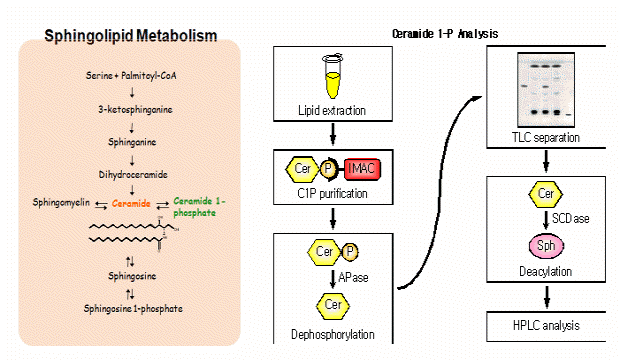
-
Adipocyte Differentiation
Adipocytes are a major site for energy storage (in the form of triglycerides) for use during periods of caloric insufficiency. Adipocyte differentiation has important implications for human diseases such as type II diabetes, hypertension and coronary heart disease. Ceramide and ceramide 1-phosphate, bioactive sphingolipids, are also implicated in diverse cellular processes such as differentiation, cell proliferation, apoptosis and inflammation.
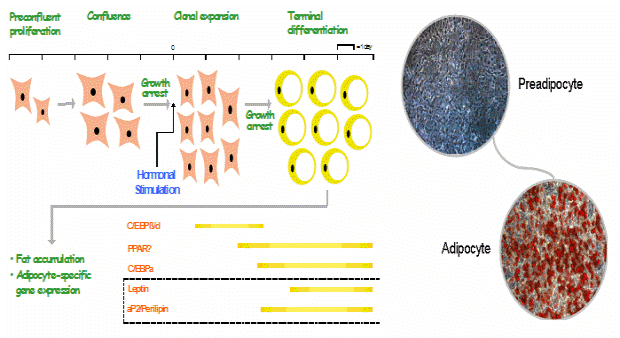
-
Antitumor Activity
Myriocin, antifungal metabolite, inhibits B16F10 melanoma cell proliferation without cytotoxicity via G2/M arrest and reduces the levels of sphingolipid me tabolites. The myriocin inhibition of cell proliferation in the melanoma cells may occur by blocking the sphingolipid biosynthesis pathway and depleting sphingosine, ceramide and ceramide 1-phosphate.
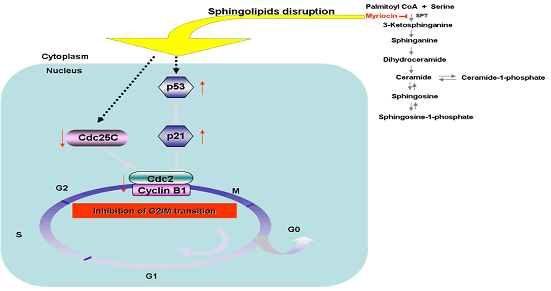
Selected Publications
-
Yoo, H.S.; Hong J.T.; Lee, Y.M.; Yun, Y.P.; Lee, Y.S.; Choi, K.M.; Choi, M.H.; Ji, S.Y.; Yoo, J.M. Simultaneous HPLC Analysis of Ceramide and Dihydroceramide in Human Hairs. Arch. Pharm. Res. 2009, 32, 1795-1801.
-
Yoo, H.S.; Shin, H.W.; Kim, D.; Lee, Y.S.; Lee, B.J.; Kim, J.S.; Jang, S.; Lim, H.; Lee, Y.; Oh, S. Alteration of sphingolipid me
tabolism and pSTAT3 ex pression by dietary cholesterol in the gallbladder of hamsters. Arch. Pharm. Res. 2009, 32, 1253-1262.
-
Yoo, H.S.; Yun, Y.P.; Pyo, M.Y.; Hong J.T.; Im, J.H., Jin, Y.R.; Lee, J.J.; Yu, J.Y.; Han, X.H.; Im, S.H. Antiplatelet activity of β-carboline alkaloids from Perganum harmala: A possible mechanism through inhibiting PLCγ2 phosphorylation. Vascul. Pharmacol. 2009, 50, 147-152.
-
Yoo, H.S.; Yoon, C.H.; Kim, M.J.; Park, M.T.; Byun, J.Y.; Lee, Y.M.; Hyun, J.W.; Lee, S.J. Activation of p38 Mitogen-Activated Protein Kinase Is Required for Death Receptor-Independent Caspase-8 Activation and Cell Death in Response to Sphingosine. Mol. Cancer Res. 2009, 7, 361-370.
-
Yoo, H.S.; Lee, Y.M.; Yim, Y.H.; Jin, Y.X.; Shi, L.H.; So, H.Y.; Kihara, A.; Igarshi, Y. A sphingosine kinase activity assay using direct infusion electrospray ionization tandem mass spectrometry. Anal. Biochem. 2008, 380, 35-40.
-
Yoo, H.S.; Lee, Y.M.; Oh, S.; Suh, S.H.; Jang, S. Changes in iNOS, GFAP and NR1 ex
pression in various brain regions and elevation of sphingosine-1-phosphate in serum after immobilized stress. Neurochem. Res. 2008, 33, 842-851.
-
Yoo, H.S.; Mitsutake, S.; Yokose, U.; Kato, M.; Matsuoka, I.; Yoo, J.M.; Kim, T.J.; Fujimoto, K.; Ando, Y.; Sugiura, M.; Kohama, T.; Igarashi, Y. The generation and behavioral analysis of ceramide kinase-null mice, indicating a function in cerebellar Purkinje cells. Biochem. Biophys. Res. Commun. 2007, 363, 519-524.
-
Yoo, H.S.; Kim, T.J.; Jeon, J.; Jin, Y.R.; Son, D.J.; Hong J.T.; Ryu, C.K.; Shin, H.S.; Lee, K.H.; Yun, Y.P. Effects of KTJ740, a novel Antithrombotic agent, on platelet-derived growth factor-induced rat aortic smooth muscle cell proliferation and cell cycle progression. J. Cardiovasc. Pharmacol. 2007, 49, 280-286.
-
Yoo, H.S.; Burenjargal, M.; Lee, Y.S.; Yoo, J.M.; Kim, Y.C.; Lee, Y.M.; Oh, S.; Yun, Y.P.; Hong J.T.; Chung, Y.B.; Moon, D.C. Endogenous sphingolipid me
tabolites related to the growth in Sphingomonas chungbukensis. Arch. Pharm. Res. 2007, 30, 317-322.
-
Yoo, H.S.; Jang, S.; Lee, J.H.; Choi, K.R.; Kim, D.; Oh, S. Cytochemical alterations in the rat retina by LPS administration. Neurochem. Res. 2007, 32, 1-10.
-
Yoo, H.S.; Lee, Y.M.; Kim, D.H.; Kie, J.H.; Jang, S.; Oh, S. Elevation of sphinganine 1-phosphate as a predictive biomarker for fumonisin exposure and toxicity in mice. J. Toxicol. Environ. Health Part A. 2006, 69, 2071-2082.
-
Yoo, H.S.; Park, H.K.; Park, E.C.; Bae, S.W.; Park, M.Y.; Kim, S.W.; Tudev, M.; Ko, Y.H.; Choi, Y.H.; Kim, S.; Lee, B.B.; Yoon, J.B.; Park, J.E.; Kim, Y.W.; Kim, D.I. ex
pression of heat shock protein 27 in human atherosclerotic plaques and increased plasma level of heat shock protein 27 in patients with acute coronary syndrome. Circulation. 2006, 114, 886-893.
-
Yoo, H.S.; Kim, Y.J.; Suh, S.H.; Oh, S.; Park, H.S.; Lee, H.Y.; Ha, E.H. Reduced L-arginine level and decreased placental eNOS activity in preeclampsia. Placenta. 2006, 27, 438-444.
-
Yoo, H.S.; Yun, Y.P.; Hong J.T.; Lee, Y.M.; Lee, Y.S.; Choi, H.K.; Oh, S.; Yoo, J.M. Protection of LLC-PK1 cells against hydrogen peroxide-induced cell death by modulation of ceramide level. Arch. Pharm. Res. 2005, 28, 311-318.
-
Yoo, H.S.; Lee, Y.S.; Park, J.E.; Bae, S.W.; Stuhlinger, M.C.; Lee, S.H.; Choi, Y.H.; Pachinger, O.; Choi, B.Y.; Park, H.K.; Yu, K.H. Plasma asymmetric dimethylarginine concentrations in newly diagnosed patients with acute myocardial infarction or unstable angina pectoris during two weeks of medical treatment. Am. J. Cardiol. 2005, 95, 729-733.
- Interleukin-32 gamma attenuates ethanol-induced liver injury by the inhibition of cytochrome P450 2E1 e-pression and inflammatory responses, Clinical Science, 2015
- Memory impairment in estrogen receptor alpha knockout mice through accumulation of amyloid-beta peptides, Molecular Neurobiology, 2015
- Anti-cancer effect of N-(3,5-bis(trifluoromethyl)phenyl)-5-chloro-2,3-dihydronaphtho[1,2-b]furan-2-carboxamide, a novel synthetic compound, Molecular Carcinogenesis, 2016
- Dodeca-2(E),4(E)-dienoic acid isobutylamide enhances glucose uptake in 3T3-L1 cells via activation of Akt signaling, Molecular and Cellular Biochemistry, 2017
- Activated natural killer cells mediate the suppressive effect of interleukin-4 on tumor development via STAT6 activation in an atopic condition melanoma model1,2, Neoplasia, 2017
- 3,3-Diindolylmethane Enhances Glucose Uptake Through Activation of Insulin Signaling in 3T3-L1 Adipocytes, Obesity, 2018
Patents
-
알칼라인 포스파타아제의 탈인산화 후 오-프탈알데히드 유도체를 사용한 생체내 스핑고지질 1-인산과 스핑고지질의 동시정량 분석법 (특허등록:제0471943호)
-
신남알데히드 유도체 화학물을 함유하는 염증성 질환의 예방 및 치료용 약학조성물 (특허등록:제0676761호)
-
토마토로부터 리코펜을 직접 추출하는 방법(특허등록:제0692253호)
-
내부 표준물질을 이용한 생체시료내 세라마이드의 정량분석방법(특허등록:제0892988호)
- 파이토세라마이드를 포함하는 뇌혈관질환의 예방 및 치료용 의약 조성물 및 식품 조성물(특허출원:제20080079886호)
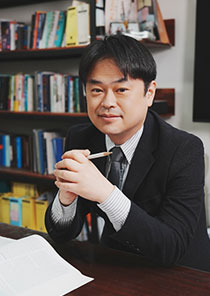
윤재석
- Subject
- Pharmacology, Health and pharmaceutical affairs law
- Phone
- 043-261-2827
- jyun@chungbuk.ac.kr
- URL
- Go home page
-
Education & Career
- 2008.4.1 – 2012.3.26 Ph.D. Graduate school of Medicine NAGOYA UNIVERSITY, JAPAN
- 1999.3.2 – 2001.2.24 M.S. College of Pharmacy CHUNGBUK NATIONAL UNIVERSITY, REPUBLIC OF KOREA
- 1995.3.2 – 1999.2.25 B.S. College of Pharmacy CHUNGBUK NATIONAL UNIVERSITY, REPUBLIC OF KOREA
- 2018.9.1- present Professor, Chungbuk National University, REPUBLIC OF KOREA
- 2017.3.1 - 2018.8.31 Professor, Wonkwang University, REPUBLIC OF KOREA
- 2012.4.1- 2012.11.3O POST DOC fellowship, Graduate school of Medicine NAGOYA UNIVERSITY, JAPAN
- 2004.5.10 – 2017.2.28 SCIENTIFIC RESEARCHER, MINISTRY OF FOOD AND DRUG SAFETY, NATIONAL INSTITUTE OF FOOD AND DRUG SAFETY EVALUATION, REPUBLIC OF KOREA
Research Areas
-
약물 의존성 형성의 기전 및 타겟 분자 규명 연구
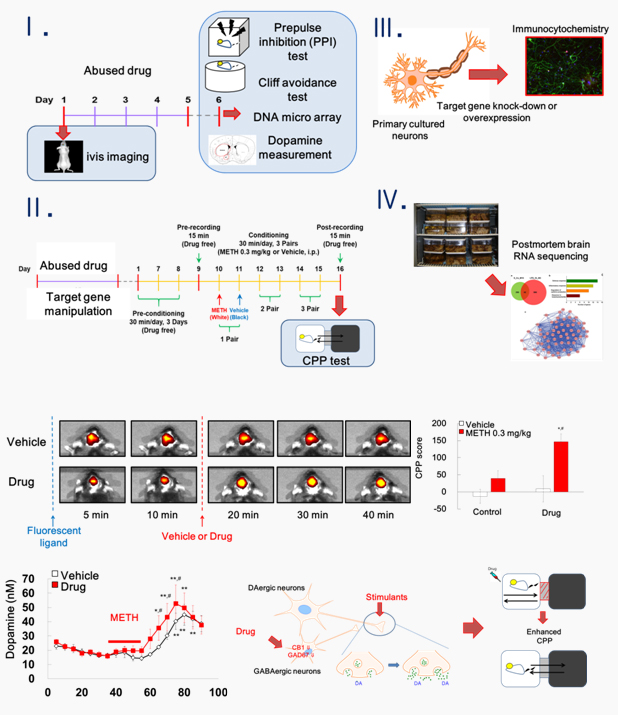
-
스트레스 반응 분자 규명 및 정신질환 상관성 연구
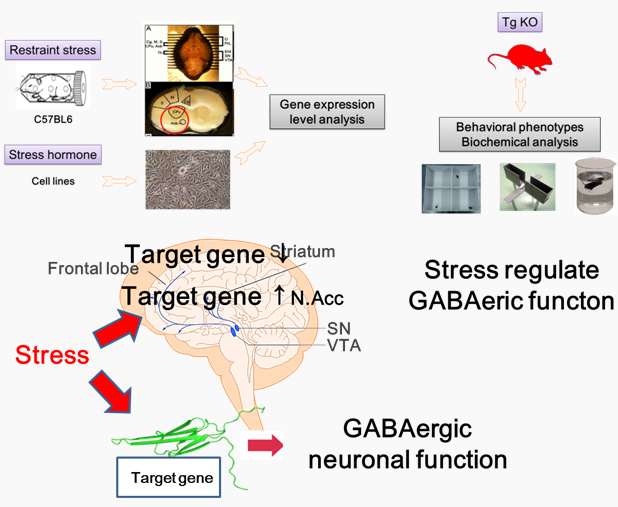
Publication
Patents
- Therapeutic Agent for Drug Abuse and Addiction Comprising L-THP as Active Ingredient, Patent No. 1010540930000. Jul. 28, 2011
- Therapeutic Agent for Drug Abuse and Addiction Comprising Baicalein as Active Ingredient, Patent No. 1008043120000. Feb. 11, 2008
- Therapeutic Agent for Drug Abuse and Addiction Comprising Baicalin as Active ingredient, Patent No. 1008043110000. Feb. 11, 2008
- Anodynes with Reduced Drug Addiction, Patent No. 1007794190000. Nov. 20, 2007
- Therapeutic Agent for Drug Abuse and Addiction Comprising Saikosaponin A as Active Ingredient, Patent No. 1007499310000. Aug. 17, 2007
- Therapeutic Agent for Narcotics Addiction, Patent No. 1007159390000. May. 2, 2007

이경은
- Subject
- Clinical Pharmacy
- Phone
- 043-261-3590
- kaylee@chungbuk.ac.kr
- URL
- Go home page
-
Education & Career
- 1996-2000: BS, College of Pharmacy, Dongduk Womens University
- 2007-2009: PharmD, College of Pharmacy, Massachusetts College of Pharmacy and Health Science
- 2011-2013: MS, College of Pharmacy & Division of Life and Pharmaceutical Sciences, Ewha Womans University
- 2013-2016: PhD, College of Pharmacy & Division of Life and Pharmaceutical Sciences, Ewha Womans University
- 2001-2004: Quality control pharmacist at Samyang Genex Corp., Korea
- 2005-2006: Pharmacy intern in Boston Medical Center, USA
- 2006-2010: Clinical pharmacist in Boston Medical Center, USA
- 2012: Research pharmacist in Yonsei Severance Cardiovascular Hospital, Korea
Research Areas
-
Phaarmacogenomics study of biologic agents in rheumatoid arthritis
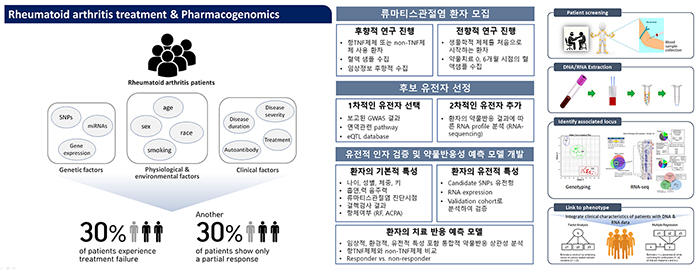
-
Pharmacogenetics of warfarin therapy
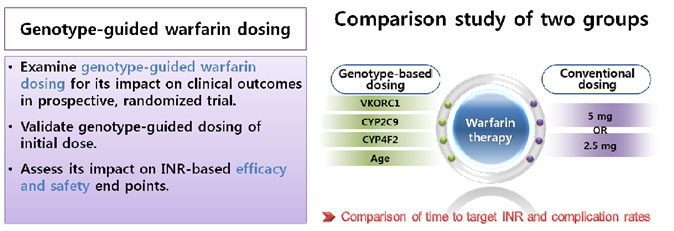
-
Prospective and retrospective clinical practice studies
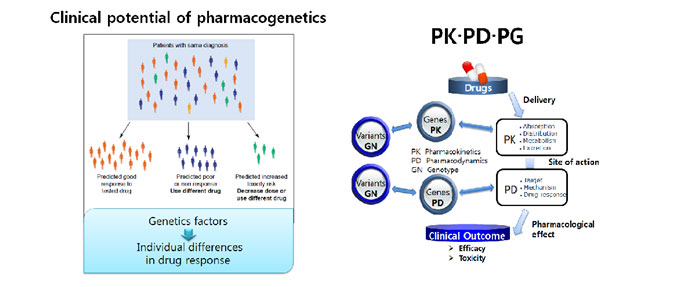
Selected Publications
- Kim K, Yee J, Kim JH, Chung JE, Lee KE, Song G, Han JM, Gwak HS. Health Behaviors Associated with Aggression in Korean Adolescents: Data From 2 Cross-sectional Studies. Am J Health Behav. 2020;44(2):271-282
- Chung JE, Yee J, Hwang HS, Park JY, Lee KE, Kim YJ, Gwak HS. Influence of GRK5 gene polymorphisms on ritodrine efficacy and adverse drug event in preterm labor treatment. Scientific Reports. 2020;10:1351
- Kim Y, Lee N, Lee KE, Gwak HS. Risk factors for sodium overcorrection in non-hypovolemic hyponatremia patients treated with tolvaptan. European Journal of Clinical Pharmacology. 2020;76:723-729
- Kim HJ, Trinh NT, Choi Y, Kim W, Min KH, Kang SO, Kim JH, Kim HA, Jung JY, Choi IA, Lee KE. ADAM17 Genetic Variants and the Response of TNF-α Inhibitor in Rheumatoid Arthritis Patients. Pharmacogenomics and Personalized Medicine. 2020:13 81–88
-
Denese E, Raimondi S, Gwak HS, Lee KE, et al., Effect of CYP4F2, VKORC1, and CYP2C9 in Influencing Coumarin Dose: A Single-Patient Data me
ta-Analysis in More Than 15,000 Individuals. Clinical Pharmacoloty & Therapeutics. 2019; 105(6):1477-1491 - Kim JY, Ku YS, Kim HJ, Trinh NT, Kim W, Jeong B, Heo TY, Lee MK, Lee KE. Oral diabetes medication and risk of dementia in elderly patients with type 2 diabetes. Diabetes Research and Clinical Practice. 2019; 154:116-123
- Yee J, Kim W, Chang BC, Chung JE, Lee KE, Gwak HS. APOB gene polymorphisms may affect the risk of minor or minimal bleeding complications in patients on warfarin maintaining therapeutic INR. European Journal of Human Genetics. 2019;27(10):1542-1549
- Kim W, Yee J, Chang BC, Chung JE, Lee KE, Gwak HS. Association between HNF4A mutations and bleeding complications in patients with stable international normalized ratio. Pharmacogenetics and Genomics. 2019;29:200–206
- Yee J, Hwang HS, Chung JE, Park JY, Lee KE, Kim YJ, Gwak HS. Effects of PDE4 gene polymorphisms on efficacy and adverse drug events of ritodrine therapy in preterm labor patients: a prospective observational study. European Journal of Clinical Pharmacology (2019) 75:1379–1386
- Lee KE, Yee J, Lee GY, Chung JE, Seong JM, Chang BC, Gwak HS. Genotype-guided warfarin dosing may benefit patients with mechanical aortic valve replacements: randomize controlled study. Scientific Reports. 2020;10:6988
- Yee J, Kim W, Chang BC, Chung JE, Lee KE, Gwak HS. Association between VEGFA gene polymorphisms and bleeding complications in patients maintaining therapeutic international normalized ratio. Pharmacogenomics. 2019 May 8
- Park JH, Lee KE, Yu YM, Park YH, Choi SA. Incidence and Risk Factors for Venous Thromboembolism After Spine Surgery in Korean Patients. World Neurosurg. 2019 Apr 25
-
Yee J, Kim W, Chang BC, Chung JE, Lee KE, Gwak HS. Genetic variations in the transc
ription factors GATA4 and GATA6 and bleeding complications in patients receiving warfarin therapy. Drug Design, Development and Therapy 2019;13:1717-1727. - Yee J, Kim W, Chang BC, Chung JE, Lee KE, Gwak HS. Effects of Polymorphisms in Myc-Related Genes on Bleeding Complications in Patients with Stable Warfarin Responses. Cardiovascular Therapeutics 2019;Article ID 1813747
- Chung JE, Song GJ, Kim K, Yee J, Kim JH, Lee KE, Gwak HS. Association between anxiety and aggression in adolescents: a cross-sectional study. BMC Pediatrics 2019;19:115
- Lee M, Yee J, Kim JY, Kim JY, An SH, Lee KE, Gwak HS. Risk factors for neutropenia and febrile neutropenia following prophylactic pegfilgrastim. Asia Pac J Clin Oncol. 2019 Apr 17.
-
Kim JH, Yee J, Lee GY, Lee KE, Gwak HS. Comparison of Approval Process for Nonpresc
ription Drugs in Different Countries. Korean J Clin Pharm, 2018;28(4):263-272. - Yi, BR, Kim HJ, Park HS, Cho YJ, Kim JY, Yee J, Chung JE, Kim JH, Lee KE, Gwak HS. Association between MKRN3 and LIN28B polymorphisms and precocious puberty. BMC Genetics 2018;19:47.
- Chung JE, Choi SA, Kim KT, Yee J, Kim JH, Seong JW, Seong JM, Kim JY, Lee KE, Gwak HS. Smartphone addiction risk and daytime sleepiness in Korean adolescents. J Paediatr Child Health 2018 Jul;54(7):800-806.
- Chung JE, Choi SA, Hwang HS, Park JY, Lee KE, Yee J, Kim YJ, Gwak HS. Association between ß2-adrenergic receptor gene polymorphisms and adverse events of ritodrine in the treatment of preterm labor: a prospective observational study. BMC Genetics 2017;18:96.
- Baek MY, Hwang HS, Park JY, Chung JE, Lee KE, Lee GY, Seong JW, Yee J, Kim YJ, Gwak HS. Association between CACNA1C gene polymorphisms and ritodrine-induced adverse events in preterm labor patients. Eur J Clin Pharmacol. 2017 Jul;73(7):837-842.
- Lee KE, Chung JE, Cho YJ, Kim HJ, Lee GY, Kim JH, Chang HC, Gwak HS. Influence of NR3C1 and VDR polymorphisms on stable warfarin dose in patients with mechanical cardiac valves. Int J Cardiol. 2017;236:393-397.
- An YH, Yu SJ, Kim IS, Kim SH, Moon JM, Kim SH, Choi YH, Choi JS, Im SG, Lee KE, Hwang NS. Hydrogel functionalized Janus membrane for skin regeneration. Adv Healthcare Mater. 2017;6(5):1600795.
- BR Lee, KE Lee. Independent Data Monitoring Committees: Review of Current Guidelines. Korean J Clin Pharm, 2016;26(2):181-186.
- Lee KE, Kim JH, Chung JE, Lee GY, Cho YJ, Chang BC, Gwak HS Association of inflammatory gene polymorphisms with mechanical heart valve reoperation. Springerplus. 2016;5(1):937.
- Park KH, Shin KS, Zhao TT, Park HJ, Lee KE, Lee MK. L-DOPA modulates cell viability through the ERK-c-Jun system in PC12 and dopaminergic neuronal cells. Neuropharmacology. 2016;101:87-97.
- Chung JE, Chang BC, Lee KE, Kim JH, Gwak HS. Effects of NAD(P)H quinone oxidoreductase 1 polymorphisms on stable warfarin doses in Korean patients with mechanical cardiac valves. Eur J Clin Pharmacol 2015;71(10):1229-36.
- An SH, Chang BC, Lee KE, Gwak HS. Influence of UDP-Glucuronosyltransferase Polymorphisms on Stable Warfarin Doses in Patients with Mechanical Cardiac Valves. Cardiovasc Ther 2015;33:324-328.
- You JB, Choi AY, Baek J, Oh MS, Im SG, Lee KE*, Gwak HS. Application of Monodirectional Janus Patch to Oromucosal Delivery System. Adv. Healthcare Mater. 2015;4:2229-2236.
- Kyung Eun Lee PharmD, Byung Chul Chang MD, PhD, Sunny Park, Hye Sun Gwak. Effects of single nucleotide polymorphisms in c-Myc on stable warfarin doses in patients with cardiac valve replacements. Pharmacogenomics. 2015;16(10):1101-1108.
- Moon JY, Lee KE, Chang BC, Jeong E, Jeong H, Gwak HS. Combined effects of hepatocyte nuclear factor 4α and constitutive androstane receptor on stable warfarin doses. Pharmacogenet Genomics. 2015 Jan 25(1): 38-40.
- Park JY, Lee NR, Lee KE, Park S, Kim YJ, Gwak HS. Effects of β2-adrenergic receptor gene polymorphisms on ritodrine therapy in pregnant women with preterm labor: prospective follow-up study. Int J Mol Sci. 2014 Jul 21;15(7):12885-94.
- Jeong E, Lee KE, Jeong H, Chang BC, Gwak HS. Impact of GATA4 variants on stable warfarin doses in patients with prosthetic heart valves. Pharmacogenomics J. 2015 Feb;15(1):33-7.
- An SH, Lee KE, Chang BC, Gwak HS. Association of gene polymorphisms with the risk of warfarin bleeding complications at therapeutic INR in patients with mechanical cardiac valves. J Clin Pharm Ther. 2014 Jun;39(3):314-8.
-
Sunny Park, Na Ra Lee, Kyung Eun Lee, Jin Young Park, Young Ju Kim, and Hye Sun Gwak. Effects of single nucleotide polymorphisms of FMO3 and FMO6 genes on pharmacokinetic characteristics of sulindac sulfide in premature labor. Drug me
tab Dispos. 2014 Jan;42(1):40-3. - Kyung Eun Lee, Yun Jung Choi, Byu Ree Oh, In Koo Chun, Hye Sun Gwak, Formulation and in vitro/in vivo evaluation of levodopa transdermal delivery systems. Int J Pharm. 2013; 456: 432-436.
- Yoon IK, Choi YJ, Chang BC, Lee KE, Rhie JY, Lee BK, Gwak HS. Effects of inflammatory cytokine gene polymorphisms on warfarin maintenance doses in Korean patients with mechanical cardiac valves. Arch Pharm Res. 2014 Jun;37(6):752-9.
- Lee KE, Hwang SJ, Lee BK, Bae SJ, Gwak HS, Rhie JY. A cross-sectional study of factors related to gastrointestinal drug use in Korean adolescents. Arch Pharm Res. 2013;10:1238-43.
- Kim HO, Lee KE, Park HY, Lee NR, Oh BR, Chang BC, Gwak HS. Effects of torsemide on pharmacodynamics and pharmacokinetics of warfarin in humans and rats. J Pharm Pharmacol. 2013; 65(8): 1195-1203.
- Kim EJ, Lee KE, Gwak HS. Analysis of Ethnic Differences in Physician’s Desk Reference. Kor J Clin Pharm. 2013; 23(2): 123-128.
- Choi AY, Kim CT, Park HY, Kim HO, Lee NR, Lee KE, Gwak HS. Pharmacokinetic characteristics of capsaicin-loaded nanoemulsions fabricated with alginate and chitosan. J Agr Food Chem. 2013; 61(9): 2096-2102.
- Lee KE, Yoon IK, Lee JK, Chang BC, Gwak HS. Adequate intensity of warfarin therapy for Korean patients with mechanical cardiac valves. J Heart Valve Dis. 2013;22:102-109.
- Jung SJ, Lee SS, Lee KE, Lee BK, Gwak HS. Perception and attitude towards antidepressants in Koreans. Kor J Clin Pharm. 2012: 22(1): 65-72.
- Lee KE. Milnacipran for treatment of fibromyalgia: A review of clinical trials. Kor J Clin Pharm. 2010; 20(3): 229-234.

이미경
- Subject
- Pharmacognosy
- Phone
- 043-261-2818
- mklee@chungbuk.ac.kr
-
Education & Career
- 1988-1992: BS, College of Pharmacy, Seoul National University
- 1992-1994: MS, Synthetic Medicinal Chemistry, Seoul National University
- 1994-2000: Ph.D, Synthetic Medicinal Chemistry, Seoul National University
- 2000-2001: Post Doc. National Institute of Health, Korea
- 2001-2003: Post Doc. NIDDK, National Institute of Health, USA
- 2004-2005: Research associate, Research Institute of Pharmaceutical Science, Seoul National University
- 2006-2007: Director, Institute for Life Science, Elcom Science Co.Ltd.
- 2008-2008: Research Professor, Institute of Nano-Bio Technology, Ewha Womans University
- 2008-present: Assistant Professor, College of Pharmacy, Chungbuk National University
Research Areas
-
천연물의 성분 연구
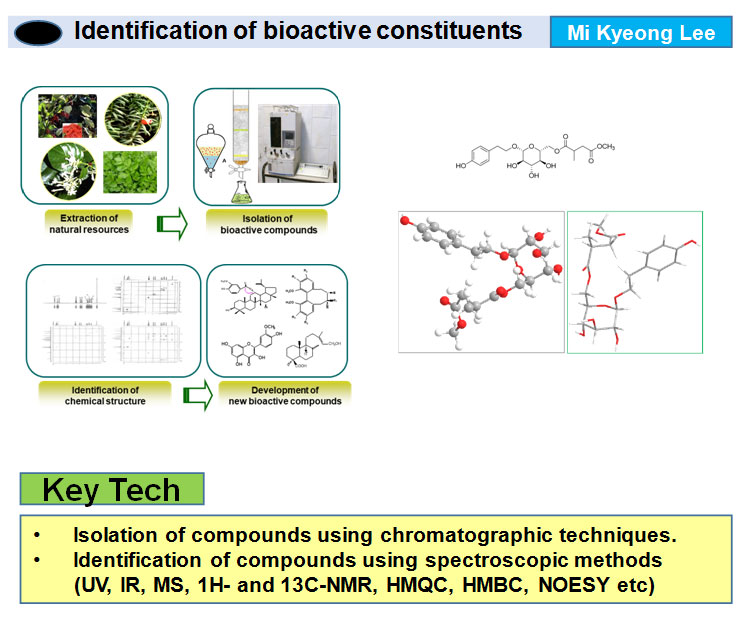
-
천연물의 부위, 성숙단계 및 배양조건에 따른 성분 비교
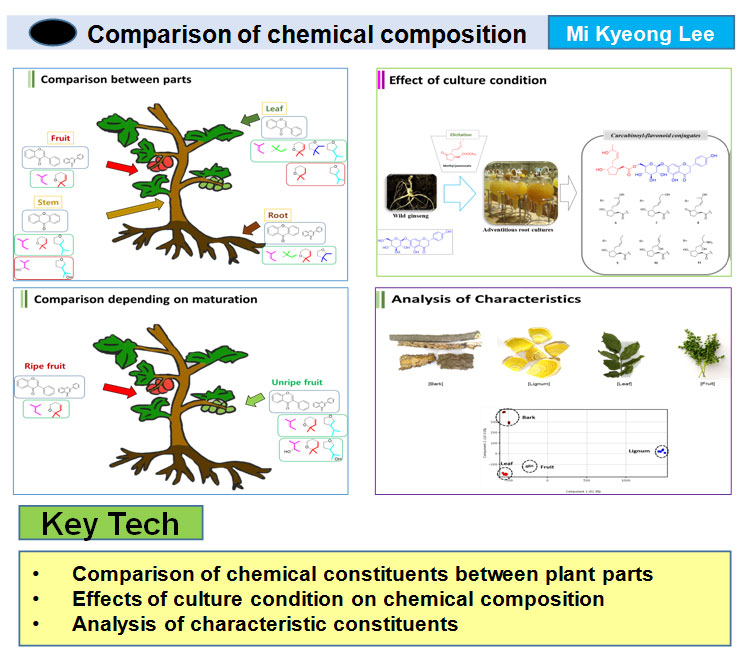
Selected Publications
- Kim SB, Liu Q, Ahn JH, Jo YH, Turk A, Hong IP, Han SM, Hwang BY, Lee MK (2018). Polyamine derivatives from the bee pollen of Quercus mongolia with tyrosinase inhibitory activity. Bioorganic Chemistry 81: 127-133
- Ahn JH, Jo YH, Kim SB, Turk A, Oh KE, Hwang BY, Lee KY, Lee MK (2018). Identification of antioxidant constituents of the aerial part of Plantago asiatica using LC–MS/MS coupled DPPH assay. Phytochemistry Letters 26: 20-24
- Jang JY, Shin H, Lim JW, Ahn JH, Jo YH, Lee KY, Hwang BY, Jung SJ, Kang SY, Lee MK (2018). Comparison of antibacterial activity and phenolic constituents of bark, lignum, leaves and fruit of Rhus verniciflua. PLoS One. 13(7):e0200257.
- Song DH, Jo YH, Ahn JH, Kim SB, Yun CY, Kim Y, Hwang BY, Lee MK (2018). Sesquiterpenes from fruits of Torilis japonica with inhibitory activity on melanin synthesis in B16 cells. J Nat Med. 72, 155-160.
-
Yang HH, Oh KE, Jo YH, Ahn JH, Liu Q, Turk A, Jang JY, Hwang BY, Lee KY, Lee MK (2018). Characterization of tyrosinase inhibitory constituents from the aerial parts of Humulus japonicus using LC-MS/MS coupled online assay. Bioorg Med Chem. 15;26(2):509-515.
-
Ahn JH, Mo EJ, Jo YH, Kim SB, Hwang BY, Lee MK (2017). Variation of loganin content in Cornus officinalis fruits at different extraction conditions and maturation stages. Biosci Biotechnol Biochem. 81(10):1973-1977.
-
Mo EJ, Ahn JH, Jo YH, Kim SB, Hwang BY, Lee MK (2017). Inositol Derivatives and Phenolic Compounds from the Roots of Taraxacum coreanum. Molecules. 14;22(8). E1349.
-
Jo YH, Kim SB, Liu Q, Hwang BY, Lee MK (2017). Prenylated Xanthones from the Roots of Cudrania tricuspidata as Inhibitors of Lipopolysaccharide-Stimulated Nitric Oxide Production. Arch Pharm (Weinheim). 350, E1600263
-
Liu Q, Jo YH, Kim SB, Jin Q, Hwang BY, Lee MK (2016). Sesquiterpenes from the roots of Lindera strychnifolia with inhibitory effects on nitric oxide production in RAW 264.7 cells. Bioorg Med Chem Lett. 15;26(20):4950-4954
- Lee JW, Mo EJ, Choi JE, Jo YH, Jang H, Jeong JY, Jin Q, Chung HN, Hwang BY, Lee MK (2016) Effect of extraction conditions of Red Ginseng on antioxidant activity, extraction yield and the contents of ginsenoside Rg1 and phenolics: Optimization using response surface methodology. J Ginseng Res 40: 229-236.
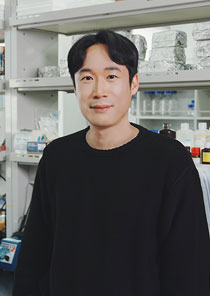
임기환
- Subject
- Biology in Pharmaceutical Sciences
- Phone
- 043-261-2993
- khlim@chungbuk.ac.kr
- URL
- Go home page
-
Education & Career
- 2007 : B.S. in Genetic Engineering, Sungkyunkwan University
- 2009 : M.S. in Molecular Biology, School of Medicine, Sungkyunkwan University
- 2015 : Ph.D. in Molecular Immunology, CHA University
- 2015-2016 : Postdoctoral Fellow, College of Pharmacy, Ajou University
- 2016-2018 : Research Assistant Professor, College of Pharmacy, Ajou University
- 2018-2022 : Senior Researcher, Korea Brain Research Institute
- 2022-Present: Assistant Professor, College of Pharmacy, Chungbuk National University
Research Areas
- Identification of novel molecular targets for Infectious Disease
- Intracellular protein quality control and neurodegenerative disease mechanisms
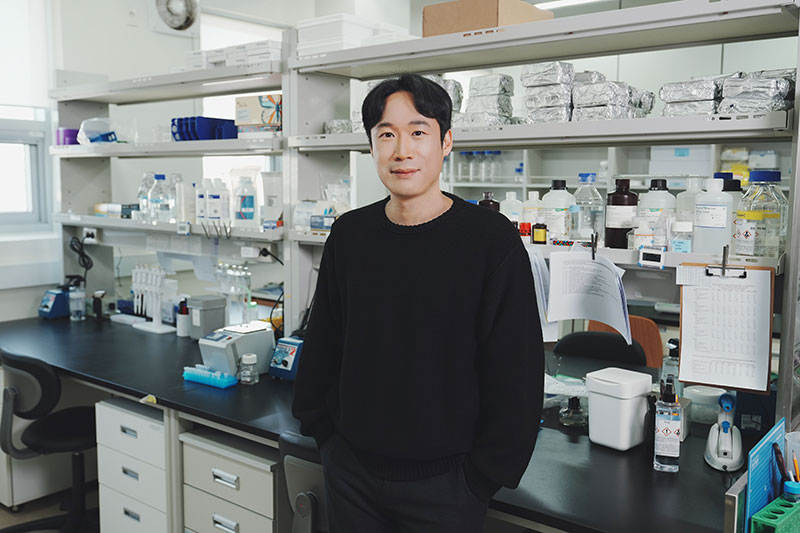
Selected Publications
-
Lim KH, Yang S, Kim SH, Joo JY (2020) Elevation of Ace2 as a SARS-CoV-2 entry receptor gene ex
pression in Alzheimer's disease. J Infect 30:S0163-4453(20)30453-9. - Lim KH, Joo JY, Baek KH (2020) The potential roles of deubiquitinating enzymes in brain diseases. Ageing Res Rev, 61:101088.
- Yang S*, Lim KH*, Kim SH, Joo JY (2020) Molecular landscape of long noncoding RNAs in brain disorders. Mol Psychiatry 26(4):1060-1074 (IF: 15.992).
- Kim SH*, Lim KH*, Yang S, and Joo JY (2021) Long non-coding RNAs in brain tumors: Roles and potential as therapeutic targets. J Hematol Oncol 12:14(17).
-
Kim SH*, Yang S*, Lim KH*, Ko E, Jang HJ, Kang M, Suh PG, Joo JY (2021) Prediction of Alzheimer's disease-specific phospholipase c gamma-1 SNV by deep learning-ba
sed approach for high-throughput screening. Proc Natl Acad Sci U S A 118:e2011250118.

한상배
- Subject
- Pharmaceutical Biochemistry
- Phone
- 043-261-2815
- shan@chungbuk.ac.kr
-
Education & Career
-
1988-1992: BS, College of Pharmacy, Chungbuk National University
-
1992-1994: MS, College of Pharmacy, Chungbuk National University
-
1998-2001: Ph.D, Department of Biological Sciences, KAIST
-
1992-2007: Senior Research Scientist, KRIBB, Korea
-
2003-2004: Post Doc, NIAID, NIH, USA
-
2007-present: Professor, College of Pharmacy, Chungbuk National University
-
2011-2013: Chief, Department of Pharmacy, College of Pharmacy, Chungbuk National University
- 2015-2017: Vice dean, College of Pharmacy, Chungbuk National University
- 2019-2020: Vice dean, College of Pharmacy, Chungbuk National University
Research Areas
-
Natural killer cell therapy of cancer
Natural killer (NK) cells are large granular lymphocytes capable of clearing both virus-infected and transformed cells. NK cell cytotoxicity is controlled by the integration of activating and inhibitory receptor signaling at the NK cell immune synapse (IS) formed between NK and target cells. NK cells can also respond by producing cytokines, e.g., interferon-γ (IFN-γ) or tumor necrosis factor-α (TNF-α), and are known to be activated by cytokines like interleukin (IL)-2, IL-12, and IL-15. Activating receptors, such as DNAM-1, NKp44, and KLRB1, are upregulated, while inhibitory receptors, like KIR2DL2 and KIR3DL3, are downregulated after exposure to IL-2. In addition, increased cell-cell adhesion has been directly coupled to cytotoxicity. NK cells are able to lyse target cells but require the right combination of activating signals, and, therefore, seem more tightly regulated than IL-2-activated NK cells.
In our lab, we are focusing on the identification of cytotoxic dynamics of NK cells. Using time-lapse imaging, we examine "cytotoxic dynamics", such as killing behavior, contact dynamics, motility and directionality of NK cells as well as dying process of cancer cells.
-
Mesenchymal stem cell therapy of autoimmune diseases
Mesenchymal stem cells (MSCs) are present in diverse tissues and organs, including bone marrow, umbilical cord, adipose tissue, and placenta. MSCs can expand easily in vitro and have regenerative stem cell properties and potent immunoregulatory activity. They inhibit the functions of dendritic cells, B cells, and T cells, but enhance those of regulatory T cells by producing immunoregulatory molecules such as transforming growth factor-β, hepatic growth factors, prostaglandin E2, interleukin-10, indolamine 2,3-dioxygenase, nitric oxide, heme oxygenase-1, and human leukocyte antigen-G. These properties make MSCs promising therapeutic candidates for the treatment of autoimmune diseases. However, the detailed mechanisms by which MSCs exert their immunomodulatory functions are still incompletely understood.
In our lab, we focus on identifying the immunoregulatory mechanisms of MSCs. Our hypothesis is that MSCs might regulate the functions of immune cells (T cells, B cells, dendritic cells, and so on) via producing soluble mediators and direct cell-cell contact. To prove it, two strategies are established. First, we are trying to identify cell-type-specific soluble mediator. Second, using time-lapse imaging, we are studying the cell type-specific contact dynamics, such as contact duration, contact frequency, motility speeds, directionality, and their relevance with chemokine axis.
-
Immuno- & Onco-pharmacology
Our lab has assay systems to evaluate the efficacy of immunomodulators (stimulants and suppressants). In enzymatic assay, we general identify the direct molecular target of compounds by using kinase assay. In cellular assay, we generally test the effect of compounds on viability, proliferation and Ab production of B cells, proliferation and cytokine production of T cells, maturation of dendritic cells (6 assay parameters), and cytokine production of macrophages. In addition, we examine the effect of compounds on signaling pathways downstream from TCR, BCR, TLRs, and cytokine receptors. In animal assay, we have syngeneic tumor model (tumor growth and me
tastasis) to develop immunostimulants and inflammation models (lupus and rheumatoid arthritis) to develop anti-inflammatory drugs. We also have assay systems to evaluate the efficacy and mechanisms of anti-cancer drug candidates. In enzymatic assay, we general identify the direct molecular target of compounds by using kinase assay. In cellular assays, we examine the cytotoxic potential of compounds on more than 60 human cancer cell lines by using SRB, MTT, and SRB assay (for tumor growth inhibitor). We also examine the invasion and migration of endothelial cells (for angiogenesis blocker) and cancer cells (for me
tastasis inhibitor). We used qRT-PCR to examine the effects of compounds on gene ex pression and WB on protein ex pression/phosphorylation. In animal assay, we have syngeneic murine tumor model, xenograft human tumor model (nude mice), and lung me tastasis models.
Selected Publications
- CCL2 deficient mesenchymal stem cells fail to establish long-lasting contact with T cells and no longer ameliorate lupus symptoms. Sci Rep. 7. 41258. 2017.
- Cytokine-induced killer cells hunt cancer cells in droves in a mouse model. Can Immunol Immunother. 66(2). 193-202. 2017.
-
Cd226-/- NK cells fail to establish stable contact with cancer cells and show impaired control of tumor me
tastasis in vivo. Oncoimmunology. 6(8). e1338994. 2017 -
Testing cell-ba
sed immunotherapy for colorectal cancer. Met Mol Biol. 1765. 299-305. 2018 - Effect of a Combination of Prednisone or Mycophenolate Mofetil and Mesenchymal Stem Cells on Lupus Symptoms in MRL.Faslpr Mice. Stem Cells Int. 4273107. 2018
- CXCR3-deficient natural killer cells fail to migrate to B16F10 melanoma cells at the single cell level. Int Immunopharmacol. 63. 66-73. 2018.
- CXCR3-deficient mesenchymal stem cells fail to infiltrate into the nephritic kidney and do not ameliorate lupus symptoms in MRL. Faslpr mice. Lupus. 27(11). 1854-1859. 2018.
- Characterization of morphological changes of B16 melanoma cells under natural killer cell attack. Int Immunopharmacol. 67. 366-371. 2019.

한지민
- Subject
- Clinical Pharmacy
- Phone
- 043-249-1387
- jmhan@chungbuk.ac.kr
- URL
- Go home page
-
Education & Career:
- 1999-2003: BS, College of Pharmacy, Ewha Womans University
- 2011-2014:MS, Graduate School of Clinical Health Sciences, Ewha Womans University
- 2016-2019:Ph. D, College of Pharmacy & Division of Life and Pharmaceutical Sciences, Ewha Womans University
- 2005-2019:Registered Pharmacist, Seoul National University Hospital
- 2019-2020:Postdoctoral Fellow, College of Pharmacy, Ewha Womans University
- 2020-present: Assistant Professor, College of Pharmacy, Chungbuk National University
Research Areas
-
Pharmacovigilance researches in hemato-oncology
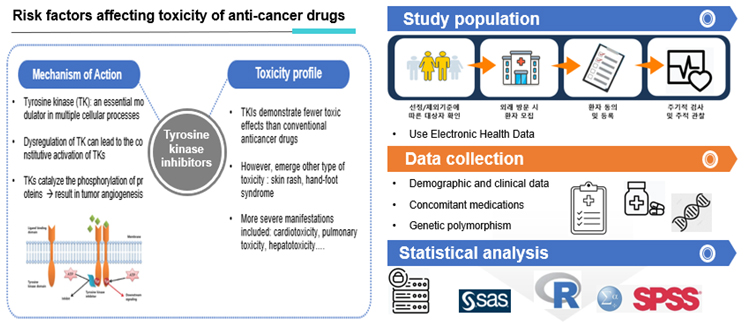
-
Medication use evaluation
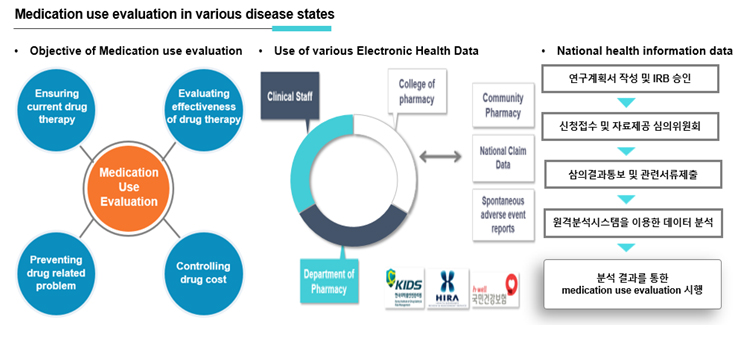
-
Outcomes of Pharmaceutical care service

Selected Publications
- Yoo HJ, Han JM, Kim K, Song G, Yee J, Chung JE, Lee JE, Gwak HS. Association between attention deficit hyperactivity disorder and aggression subscales in adolescents. Brain behav. 2021;e02030.
- Cho YA, Han JM, Kang SY, Kim DC, Youn YJ, Choi KH, Gwak HS. Analysis of risk factors for hepatotoxicity induced by immune checkpoint inhibitors. J Immunother. 2021;44(1):16-21.
-
Yoon HY, Cho YA, Yee J, Gwak HS, Han JM. Clinical and laboratory features of pediatric patients with COVID-19: systematic review and me
ta-analysis. Korean J Clin Pharm. 2020;30(4):270-278. -
Yee J, Kim W, Han JM, Yoon HY, Lee N, Lee KE, Gwak HS. Clinical manifestations and perinatal outcomes of pregnant women with COVID-19: a systematic review and me
ta-analysis. Sci Rep. 2020;10(1):18126. -
Kim W, Han JM, Lee KE. Predictors of mortality in patients with COVID-19: a systematic review and me
ta-analysis. Korean J Clin Pharm. 2020;30(3):169-176. -
Yoon HY, Ahn MH, Yee J, Lee N, Han JM, Gwak HS. Influence of CYP2C9 and CYP2A6 on plasma concentrations of valproic acid: a me
ta-analysis. Eur J Clin Pharmacol. 2020;76(8):1053-1058. - Han JM, Han HW, Yee J, Kim MK, Moon JY, Cho S, Jung D, Cho YS, Seo I, Kim JY, Gwak HS. Factors affecting high-grade hepatotoxicity of tyrosine kinase inhibitors in cancer patients: a multi-center observational study. Eur J Clin Pharmacol. 2020;76(8):1183-1191.
- Kim K, Yee J, Kim JH, Chung JE, Lee KE, Song G, Han JM, Gwak HS. Health behaviors associated with aggression in Korean adolescents: data from 2 cross-sectional studies. Am J Health Behav. 2020;44(2):271-282.
- Han JM, Yee J, Chung JE, Lee KE, Park K, Gwak HS. Effects of cytochrome P450 oxidoreductase genotypes on the pharmacokinetics of amlodipine in healthy Korean subjects. Mol Genet Genomic Med. 2020;8(5):1201.
-
Yee J, Kim SM, Han JM, Lee N, Yoon HY, Gwak HS. The association between NAT2 acetylator status and adverse drug reactions of sulfasalazine: a systematic review and me
ta-analysis. Sci Rep. 2020;10(1):3658. - Han JM, Yee J, Cho YS, Gwak HS. Factors influencing imatinib-induced hepatotoxicity. Cancer Res Treat. 2020;52(1):181-188.
-
Lee N, Park SM, Yee J, Yoon HY, Han JM, Gwak HS. Association between glutathione-S-transferase gene polymorphisms and response to tyrosine kinase inhibitor treatment in patients with chronic myeloid leukemia: a me
ta-analysis. Target Oncol 2020;15(1):47-54. - Moon JY, Lee Y, Han JM, Lee MH, Yee J, Song MK, Kim YJ, Gwak HS. Effects of pharmacist intervention on reducing prescribing errors of investigational drugs in oncology clinical trials. J Oncol Pharm Pract. 2020;26(1):29-35.
- Han JM, HS Gwak. Reviews on the hepatotoxicity of tyrosine kinase inhibitors. Korean J Clin Pharm. 2019;29(4):223-230.
- Moon JY, Han JM, Seo I, Gwak HS. Risk factors associated with the incidence and time to onset of lapatinib-induced hepatotoxicity. Breast Cancer Res Treat. 2019;178(1):239-244.
- Kim MK, Yee J, Cho YS, Jang HW, Han JM, Gwak HS. Risk factors for erlotinib-induced hepatotoxicity: a retrospective follow up study. BMC Cancer. 2018;18(1):988.
- Jung DS, Han JM, Yee J, Kim JY, Gwak HS. Factors affecting crizotinib-induced hepatotoxicity in non-small cell lung cancer patients. Med Oncol. 2018;35(12);154.
- Han JM, Ah YM, Suh SY, Jung SH, Hahn HJ, Im SA, Lee JY. Clinical and economic impact of pharmacists' intervention in a large volume chemotherapy preparation unit. Int J Clin Pharm. 2016;38:1124-1132.
- Bea H, Han J, Lee YH, Kim HS, Lee HS, Lee SH, Heo DS, Lee JY. Polypharmacy in Patients Discharged from Oncology Department. Korean J Clin Pharm. 2013;23(1):42-48.
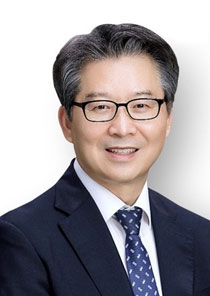
홍진태
- Subject
- Pharmacology and toxicology
- Phone
- 043-261-2813
- jinthong@chungbuk.ac.kr
-
학력
- 1980~1988 충북대학교 약학대학 (약학사, 군복문 포함)
- 1988-1990 충북대학교 대학원 약학과 (약학석사)
- 1993-1997 University of Kentucky, USA (Ph.D.)
주요경력
- 충북대학교 명예의 전당 1호로 헌정 (2020)
- 2001-현재 충북대학교 약학대학 교수
- 2008-현재 과기정통부 기초의과학연구센터(MRC) 센터장
- 2019-2020 충북대학교 약학대학 학장
- 2020-현재 대한약학회 52대 회장
- 2020-현재산자부 충북바이오헬스산업혁신센터(RIS)장
- 2021-현재 복지부 국가신약개발사업단 이사장
- 1990-2001 식약처 보건연구사/보건연구관
- 1997-2001 식약처 OECD GLP 국제사찰관
- 2001-2003 과기정통부 국가기술지도작성비전위원
- 2003 한국생명공학연구원 겸임연구원*
- 2006-2010 복지부 건강기능식품심의위원*
- 2006-2014 한국연구재단 PM, CRB
- 2009-2011 복지부 오송첨단의료산업진흥재단 추진단장*
- 2010-2015 보건복지부식약처 정부업무평가위원
- 2010-현재 충청북도 도정자문단 바이오분야 위원장*
- 2011-2017 복지부 오송첨단의료산업진흥재단 이사*
- 2011-2016 청주MBC 시청자위원회 위원
- 2012-2013 오송산학융합지구조성사업 추진단장*
- 2012-2019 복지부 건강보험심사평가원 약제급여평가위원회 위원
- 2013 정부업무평가(국정과제평가부문)전문위원*
- 2013-2014 교육과학기술부 첨단기술개발동향 조사단원
- 2013-2015 오송첨단의료산업진흥재단인사위원회 위원장*
- 2013-2019 산자부 충북산학융합본부 원장*
- 2014-2017 오송첨단의료산업진흥재단 비상임이사*
- 2015-현재 충청북도 4차산업위원회 위원*
- 2016 진천군 정책자문단 자문위원*
- 2016-2017 식약처 연구개발성과심의위원회 위원*
- 2016-2018 복지부 건강기능식품심의위원*
- 2016-2019 한국연구재단 한중기초과학 교류위원*
- 2016-현재식약처 중앙약사심의위원회 전문가*
- 2017 복지부 제약산업중장기전략기획단 일자리분과위원회 위원장*
- 2017-2018 식약처 생리대안전검증위원회 위원*
-
2017-2019 식약처 KNTP 독성시험평가전문위원회 위원*
산자부 충북산학융합본부 협의회 회장 -
2017-현재심평원 약제급여평가위원회 위원*
식약처 의약품심사자문단*
충청북도 정책자문단 바이오환경분과위원장* - 2018 식약처 정책자문위원회 위원*
-
2018-2020 행정중심복합도시 공동캠퍼스 자문위원*
식약처 갈등관리 심의위원회 위원*
식약처 정보공개심의회 위원*
식약처 정책자문위원회 위원*
식약처 위해평가전문위원회 위원*
식약처 중앙약사심의위원회 전문가* - 2018-2019 과기정통부 과학비지니스벨트 청주SB프라자 운영책임자 *
- 2018-현재 식약처 국민청원 안전검사 심의위원*
- 2018-현재 충북의약품산업협의회 위원*
-
2019-현재 충북 바이오헬스 제2도약 추진협의회 위원*
충주시 바이오산업자문위원회 위원* - 2019-현재 산자부 산학융합지구관리위원회 자문위원 *
- 2019-현재 과기정통부 국제과학비지니스벨트위원회 위원*
- 2019-현재 과기정통부 지방과학진흥협의회 위원*
- 2019-현재 식약처 자체규제심사위원회 위원*
-
2020-현재 충북 지역혁신협의회 위원*
충북 미래위원회 위원*
충북 지편찬위원회 위원* -
2021-현재 충북대산학협력단 산학협력위원회 위원*
오송뷰티시니어대회 대회장 *
건강기능식품 기능성원료 재평가사업 자문단 *
식약처 규제입증위원회 위원*
소비자정책위원회 식의약품분야 전문위원회 위원*
한국약학교육평가원 이사*
학회활동
- 2015-현재 한국응용약물학회 부회장
- 2015-2016 대한약학회 학술위원장
- 2016-2018 FIP 조직위원회 사무총장*
- 2016-현재 대한독성유전단백치학회 부회장
- 2017-2020 대한약학회 부회장, 이사
- 2017-2018 대한약학회 사무총장 선거관리위원장
- 2019 대한약리학회 부회장*
- 2019-현재 한국에프디시법제학회 사무총장, 부회장 2020-현재 대한약학회 회장
학술활동
-
SCI급 국제학술지 500편 저술
- Allergy Clinical Immunology, Nature Communications, Pharmacology & Therapeutics등 -
생물학연구정보센터(BRIC) 소개
- 한빛사 논문(2016, 2017, 2020)
- 상위피인용논문(2013. 2015, 2016, 2018 2019) - 국내특허~35건, 국제특허~11건, 저서~27권
- 교육부 BK사업팀 팀장 (2013-2015)
- 산자부 산학융합지구사업(2013-2018,사업총괄책임)
- 복지부 제약산업특성화대학원 (2012-2016, 운영책임자)
- 연구재단 한중기초과학교위원 (2016-2019)
- 중기부 화장품산업학과 (2017-현재, 계약학과 운영책임자)
- 교육부 지자체 대학협력기반 지역혁신 사업 (2010-2025,사업 총괄책임)
- 과기정통부 기초의과학연구센터(MRC) 연속 선정 (2008-현재, 센터장)
수상
- 2006 충북대학교 연구부문 우수교원
- 2007 대한독성유전단백체학회 BD 학술상
- 2010 대한약학회 약학연구상
- 2010 충청북도지사 표창
- 2012 대한약학회 활명수약학상
- 2011 충북대학교 우수학술상
- 2012 충북대학교 우수학술상
- 2014 충북대학교 우수학술상
- 2015 한국응용 약물학회 약원학술상
- 2016 충북대학교 우수교원 대상(기술이전분야)
- 2017 충북대학교 우수교원 Galaxia(산학협력분야)
- 2017 충북대학교 우수교원 Galaxia(학술연구부문)
- 2018 충북대학교 우수교원 대상(특허부문)
- 2019 충북대학교 우수교원 Galaxia(산학협력분야)
- 2020 충북대학교 총장 표창
- 2021 충북대학교 기술이전 최우수상(수임료부분)
- 2021 한국에프디시규제과학회 법제과학상
Education
- 1980-1988Chungbuk National University College of Pharmacy (Bachelor of Pharmacy, Military Uniform included)
- 1988-1990Chungbuk National University Graduate School of Pharmacy (Master of Pharmacy)
- 1993-1997 University of Kentucky, USA (Ph.D.)
Major career
- Dedicated to Chungbuk National University Hall of Fame No. 1 (2020)
- 2001-Present Professor, College of Pharmacy, Chungbuk National University
- 2008-Present Director, Center for Basic Medical Science Research (MRC), Ministry of Science and ICT
- 2019-2020 Dean, College of Pharmacy, Chungbuk National University
- 2020-Present 52nd President of the Korean Pharmaceutical Association
- 2020-Present Director, Chungbuk Bio-Health Industry Innovation Center (RIS), Ministry of Commerce, Industry and Energy
- 2021-Present Chairman, Ministry of Health and Welfare, National New Drug Development Project Group
- 1990-2001 Ministry of Food and Drug Safety Health Researcher/Health Research Officer
- 1997-2001 OECD GLP International Inspectorate, Ministry of Food and Drug Safety
- 2001-2003 Minister of Science and ICT National Technical Map Vision Committee
- 2003 Adjunct Researcher, Korea Research Institute of Bioscience and Biotechnology
- 2006-2010 Member of Health Functional Food Review Committee, Ministry of Health and Welfare
- 2006-2014 National Research Foundation PM, CRB
- 2009-2011 Director of the Osong Advanced Medical Industry Promotion Foundation, Ministry of Welfare
- 2010-2015 Ministry of Health and Welfare, Ministry of Food and Drug Safety, Government Evaluation Committee
- 2010-Present Chairman of the Bio sector of the Chungcheongbuk-do Provincial Government Advisory Group
- 2011-2017 Director, Osong Advanced Medical Industry Promotion Foundation, Ministry of Welfare
- 2011-2016 Cheongju MBC Viewers Committee Member
- 2012-2013 Osong Industry-University Convergence Zone Construction Project Director
- 2012-2019Member of Pharmaceutical Benefit Evaluation Committee, Health Insurance Review and Assessment Service, Ministry of Health and Welfare
- 2013 Government Task Evaluation (National Project Evaluation Sector) Expert Member
- 2013-2014 Member of High-tech Development Trend Survey Team, Ministry of Education, Science and Technology
- 2013-2015 Osong Advanced Medical Industry Promotion Foundation Human Resources Committee Chairman
- 2013-2019 Director, Chungbuk Industry-Academic Convergence Headquarters, Ministry of Commerce, Industry and Energy
- 2014-2017 Osong Advanced Medical Industry Promotion Foundation Non-Executive Director
- 2015-Present Member of the 4th Industry Committee of Chungcheongbuk-do
- 2016 Jincheon-gun Policy Advisory Committee Advisor
- 2016-2017Ministry of Food and Drug Safety Research and Development Performance Review Committee member
- 2016-2018 Ministry of Health and Welfare Health Functional Food Review Committee
- 2016-2019 Korea Research Foundation Korea-China Basic Science Exchange Member
- 2016-Present Expert, Central Pharmacist Review Committee, Ministry of Food and Drug Safety
- 2017 Ministry of Health and Welfare, Pharmaceutical Industry Mid/Long-term Strategic Planning Group, Job Subcommittee Chairman
- 2017-2018 Ministry of Food and Drug Safety Sanitary Napkin Safety Verification Committee Member
-
2017-2019 Ministry of Food and Drug Safety KNTP Toxicological Test Evaluation Committee Member
President of the Chungbuk Industry-Academic Convergence Headquarters Council, Ministry of Industry and Energy -
2017-Present Member of Pharmaceutical Benefits Evaluation Committee, HIRA
Ministry of Food and Drug Safety Drug Review Advisory Group
Chungcheongbuk-do Policy Advisory Group Chairman of Bio-Environment Subcommittee - 2018 Ministry of Food and Drug Safety Policy Advisory Committee Member
-
2018-2020 Administrative Central City Joint Campus Advisory Board
Member of the Conflict Management Review Committee, Ministry of Food and Drug Safety
Member of the Information Disclosure Council, Ministry of Food and Drug Safety
Member of the Ministry of Food and Drug Safety Policy Advisory Committee
Member of Risk Assessment Expert Committee, Ministry of Food and Drug Safety
Expert of the Central Pharmacist Review Committee of the Ministry of Food and Drug Safety - 2018-2019 Ministry of Science and ICT Science Business Belt Cheongju SB Plaza Operation Manager
- 2018-Present Member of the National Petition Safety Inspection Committee, Ministry of Food and Drug Safety
- 2018-Present Member of Chungbuk Pharmaceutical Industry Council
- 2019-Present Member of the Chungbuk Biohealth 2nd Leap Promotion Council Member of the Chungju-si Bio Industry Advisory Committee
- 2019-Present Advisory Committee Member, Industry-Academic Convergence District Management Committee, Ministry of Commerce, Industry and Energy
- 2019-Present Member of International Science Business Belt Committee, Ministry of Science and ICT
- 2019-Present Member of Local Science Promotion Council, Ministry of Science and ICT
- 2019-Present Member of the Ministry of Food and Drug Safety’s Self-Regulation Review Committee
-
2020-Present Member of the Chungbuk Regional Innovation Council
Member of Chungbuk Future Committee
Member of Chungbuk Paper Compilation Committee -
2021-Present Member of Industry-Academic Cooperation Committee, Chungbuk National University Industry-Academic Cooperation Foundation
Osong Beauty Senior Competition Venue
Health functional food functional ingredient reevaluation project advisory group
Member, Ministry of Food and Drug Safety Regulatory Verification Committee
Member of Consumer Policy Committee Food and Drug Specialty Committee
Director, Korea Institute of Pharmacy Education and Evaluation
Academic activities
-
Author of 500 SCI-level international academic journals
- Allergy Clinical Immunology, Nature Communications, Pharmacology & Therapeutics, etc. -
About the Center for Biological Research Information (BRIC)
- Hanbitsa Thesis (2016, 2017, 2020)
- Top Cited Papers (2013. 2015, 2016, 2018 2019) - Domestic patents - 35 cases, international patents - 11 cases, books - 27 books
- BK Project Team Leader, Ministry of Education (2013-2015)
- Industry-Academic Convergence District Project (2013-2018, general responsibility) of the Ministry of Commerce, Industry and Energy
- Ministry of Health and Welfare, Pharmaceutical Industry Specialized Graduate School (2012-2016, Operation Manager)
- Member of Korea-Chinese Basic Science School, Research Foundation (2016-2019)
- Department of Cosmetics Industry, Ministry of SMEs and Startups (2017-present, contract department operation manager)
-
Local innovation project ba
sed on local university cooperation by the Ministry of Education (2010-2025, project overall responsibility) - Continuous selection of the Basic Medical Science Research Center (MRC) by the Ministry of Science and ICT (2008-Present, Center Director)
Awards
- 2006 Chungbuk National University Research Division Excellent Professor
- 2007 Korean Toxic Genetic Proteomic Society BD Academic Award
- 2010 Pharmaceutical Research Award, Korean Society of Pharmacy
- 2010 Chungcheongbuk-do Governor Commendation
- 2012 Whal Myung Su Pharmacy Award, Korean Society of Pharmacy
- 2011 Chungbuk National University Excellence Award
- 2012 Chungbuk National University Excellence Award
- 2014 Chungbuk National University Excellence Award
- 2015 Korean Society of Applied Pharmacology Pharmacology Award
- 2016 Chungbuk National University Excellent Faculty Award (technology transfer field)
- 2017 Chungbuk National University Excellent Faculty Galaxia (Industry-University Cooperation Field)
- 2017 Chungbuk National University Excellent Faculty Galaxia (Academic Research Division)
- 2018 Chungbuk National University Excellent Faculty Award (Patent Division)
- 2019 Chungbuk National University Excellent Faculty Galaxia (Industry-University Cooperation)
- 2020 Chungbuk National University President's Award
- 2020 Dedicated to Chungbuk National University Hall of Fame No. 1
- 2021 Chungbuk National University Technology Transfer Grand Prize (in the fee part)
- 2021 Korea FDC Regulatory Science Association Legislative Science Award
Research Areas
1. 함암작용 및 치료제 개발 연구
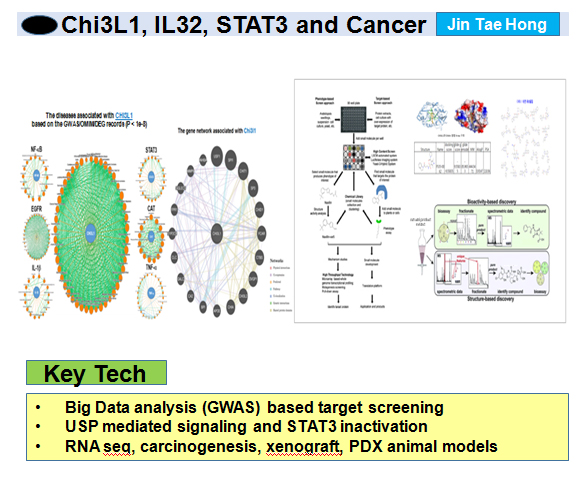
2. 신경계질환 (치매, 파킨손, 우울증 등) 원인 규명 및 치료제 개발

Selected Publications(2020-2021)
-
Lee YS, Han SB, Ham HJ, Park JH, Lee JS, Hwang DY, Jung YS, Yoon DY, Hong JT. IL-32γ suppressed atopic dermatitis through inhibition of miR-205 ex
pression via inactivation of nuclear factor-kappa B. J Allergy Clin Immunol. 2020 Jul;146(1):156-168. doi: 10.1016/j.jaci.2019.12.905. Epub 2020 Jan 10. PMID: 31931018. - Pham TH, Park HM, Kim J, Hong JT, Yoon DY. STAT3 and p53: Dual Target for Cancer Therapy. Biomedicines. 2020 Dec 21;8(12):637. doi: 10.3390/biomedicines8120637. PMID: 33371351; PMCID: PMC7767392.
- Lee DH, Jung YS, Yun J, Han SB, Roh YS, Song MJ, Hong JT. Peroxiredoxin 6 mediates acetaminophen-induced hepatocyte death through JNK activation. Redox Biol. 2020 May;32:101496. doi: 10.1016/j.redox.2020.101496. Epub 2020 Mar 8. PMID: 32171727; PMCID: PMC7068129.
- Lee YJ, Oh MJ, Lee DH, Lee YS, Lee J, Kim DH, Choi CH, Song MJ, Song HS, Hong JT. Anti-inflammatory effect of bee venom in phthalic anhydride-induced atopic dermatitis animal model. Inflammopharmacology. 2020 Feb;28(1):253-263. doi: 10.1007/s10787-019-00646-w. Epub 2019 Nov 30. PMID: 31786805.
- Lee YS, Jeon SH, Ham HJ, Lee HP, Song MJ, Hong JT. Improved Anti-Inflammatory Effects of Liposomal Astaxanthin on a Phthalic Anhydride-Induced Atopic Dermatitis Model. Front Immunol. 2020 Dec 1;11:565285. doi: 10.3389/fimmu.2020.565285. PMID: 33335525; PMCID: PMC7736086.
- Park KR, Yun HM, Yoo K, Ham YW, Han SB, Hong JT. Chitinase 3 like 1 suppresses the stability and activity of p53 to promote lung tumorigenesis. Cell Commun Signal. 2020 Mar 4;18(1):5. doi: 10.1186/s12964-019-0503-7. PMID: 32127023; PMCID: PMC7055043.
- Im JH, Yeo IJ, Hwang CJ, Lee KS, Hong JT. PEGylated Erythropoietin Protects against Brain Injury in the MCAO-Induced Stroke Model by Blocking NF-κB Activation. Biomol Ther (Seoul). 2020 Mar 1;28(2):152-162. doi: 10.4062/biomolther.2019.147. PMID: 31813204; PMCID: PMC7059808.
- Yeo IJ, Yun J, Son DJ, Han SB, Hong JT. Antifungal drug miconazole ameliorated memory deficits in a mouse model of LPS-induced memory loss through targeting iNOS. Cell Death Dis. 2020 Aug 14;11(8):623. doi: 10.1038/s41419-020-2619-5. PMID: 32796824; PMCID: PMC7429861.
- Park KR, Yun HM, Hong JT. G721-0282 inhibits cell growth and induces apoptosis in human osteosarcoma through down-regulation of the STAT3 pathway. Int J Biol Sci. 2020 Jan 1;16(2):330-341. doi: 10.7150/ijbs.37781. PMID: 31929760; PMCID: PMC6949149.
- Park KR, Yun HM, Hong JT. G721-0282 inhibits cell growth and induces apoptosis in human osteosarcoma through down-regulation of the STAT3 pathway. Int J Biol Sci. 2020 Jan 1;16(2):330-341. doi: 10.7150/ijbs.37781. PMID: 31929760; PMCID: PMC6949149.
- Park KR, Hwang CJ, Yun HM, Yeo IJ, Choi DY, Park PH, Kim HS, Lee JT, Jung YS, Han SB, Hong JT. Prevention of multiple system atrophy using human bone marrow-derived mesenchymal stem cells by reducing polyamine and cholesterol-induced neural damages. Stem Cell Res Ther. 2020 Mar 4;11(1):63. doi: 10.1186/s13287-020-01590-1. PMID: 32127052; PMCID: PMC7055099.
- Ham HJ, Lee YS, Yun J, Han SB, Son DJ, Hong JT. Anxiolytic-like effects of the ethanol extract of Magnolia obovata leaves through its effects on GABA-benzodiazepine receptor and neuroinflammation. Behav Brain Res. 2020 Apr 6;383:112518. doi: 10.1016/j.bbr.2020.112518. Epub 2020 Jan 30. PMID: 32006565.
- Ham HJ, Lee YS, Yun J, Son DJ, Lee HP, Han SB, Hong JT. K284-6111 alleviates memory impairment and neuroinflammation in Tg2576 mice by inhibition of Chitinase-3-like 1 regulating ERK-dependent PTX3 pathway. J Neuroinflammation. 2020 Nov 22;17(1):350. doi: 10.1186/s12974-020-02022-w. PMID: 33222690; PMCID: PMC7681957.
- Im JH, Yeo IJ, Park PH, Choi DY, Han SB, Yun J, Hong JT. Deletion of Chitinase-3-like 1 accelerates stroke development through enhancement of Neuroinflammation by STAT6-dependent M2 microglial inactivation in Chitinase-3-like 1 knockout mice. Exp Neurol. 2020 Jan;323:113082. doi: 10.1016/j.expneurol.2019.113082. Epub 2019 Oct 24. PMID: 31669069.
- Lee YJ, Yeo IJ, Choi DY, Yun J, Son DJ, Han SB, Hong JT. Amyloidogenic, neuroinflammatory and memory dysfunction effects of HIV-1 gp120. Arch Pharm Res. 2021 Jul;44(7):689-701. doi: 10.1007/s12272-021-01340-8. Epub 2021 Jul 23. PMID: 34302237; PMCID: PMC8300079.
- Ham HJ, Yeo IJ, Jeon SH, Lim JH, Yoo SS, Son DJ, Jang SS, Lee H, Shin SJ, Han SB, Yun JS, Hong JT. Botulinum Toxin A Ameliorates Neuroinflammation in the MPTP and 6-OHDA-Induced Parkinson's Disease Models. Biomol Ther (Seoul). 2021 Jun 3. doi: 10.4062/biomolther.2021.077. Epub ahead of print. PMID: 34078752.
-
Yu JE, Yeo IJ, Son DJ, Yun J, Han SB, Hong JT. Anti-Chi3L1 antibody suppresses lung tumor growth and me
tastasis through inhibition of M2 polarization. Mol Oncol. 2021 Dec 3. doi: 10.1002/1878-0261.13152. Epub ahead of print. PMID: 34861103. - Jeon SH, Lee YS, Yeo IJ, Lee HP, Yoon J, Son DJ, Han SB, Hong JT. Inhibition of Chitinase-3-like-1 by K284-6111 Reduces Atopic Skin Inflammation via Repressing Lactoferrin. Immune Netw. 2021 Jun 29;21(3):e22. doi: 10.4110/in.2021.21.e22. PMID: 34277112; PMCID: PMC8263211.

황방연
- Subject
- Pharmacognosy Ⅰ·Ⅱ, Natural Product Chemistry
- Phone
- 043-261-2814
- byhwang@chungbuk.ac.kr
-
Education & Career
- 1988-1992: BS, College of Pharmacy, Chungbuk National University
- 1992-1994: MS, College of Pharmacy, Chungbuk National University
- 1994-1999: Ph.D., College of Pharmacy, Chungbuk National University
- 1999-2001: Post Doc, Korea Research Institute of Bioscience and Biotechnology (KRIBB)
- 2001-2003: Post Doc, College of Pharmacy, University of Illinois at Chicago, U.S.A.
- 2003-present: Professor, College of Pharmacy, Chungbuk National University
- 2009-2011: Vice Dean, College of Pharmacy, Chungbuk National University
- 2014-2015: Visiting Scholar, College of Pharmacy, University of Illinois at Chicago, U.S.A.
Research Areas
-
천연물 유래 생리활성 물질 분리정제 및 구조규명
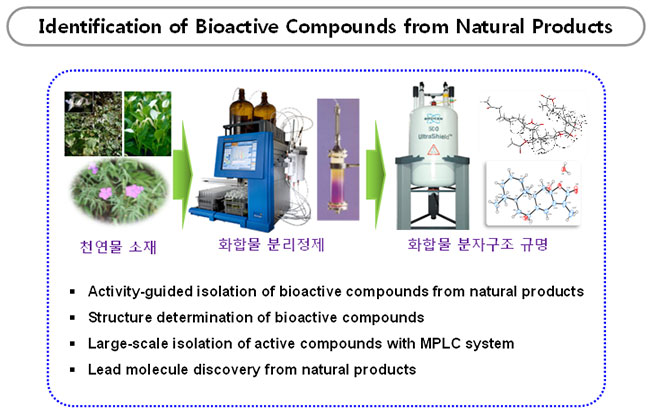
-
식물유래 항염증 활성물질 분리정제
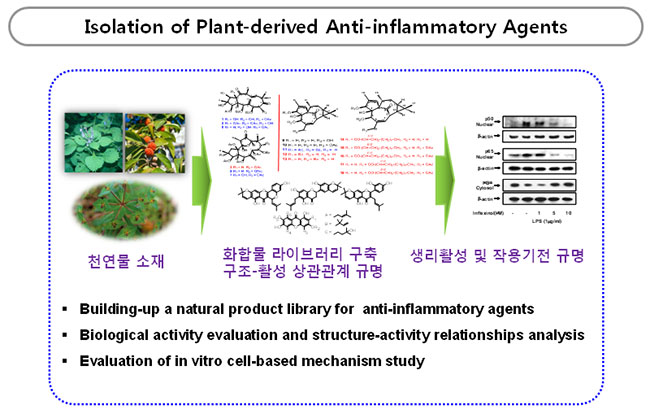
-
천연물 대사체분석
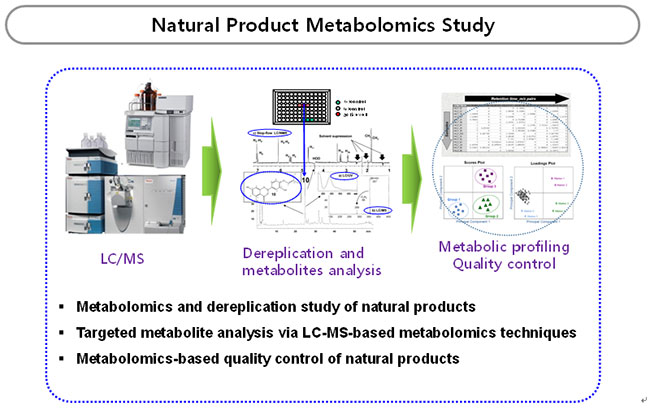
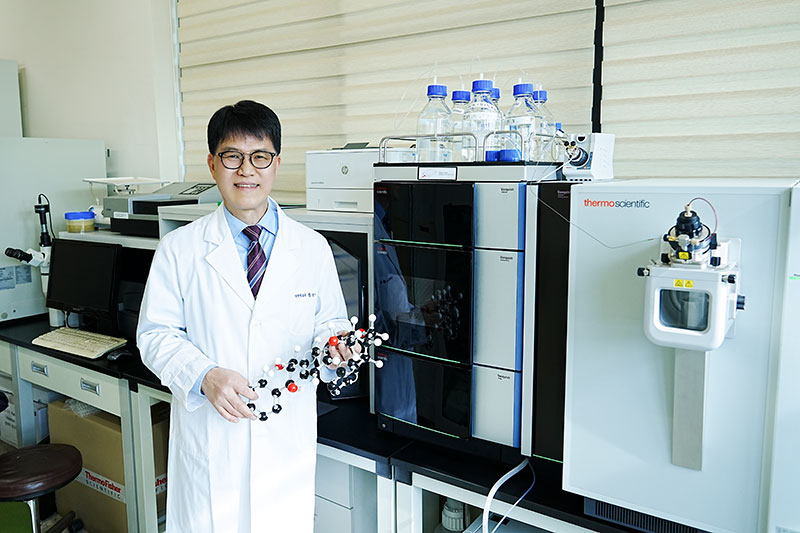
Selected Publications
- Lathyrane-Type Diterpenoids from the Seeds of Euphorbia lathyris L. with Inhibitory Effects on NO Production in RAW 264.7 Cells. Lee JW, Jin Q, Jang H, Kim JG, Lee D, Kim Y, Hong JT, Lee MK, Hwang BY. Chem Biodivers. 15(10): e1800144 (2018)
- Dimeric- and trimeric sesquiterpenes from the flower of Inula japonica. Jin Q, Lee JW, Jang H, Lee HL, Kim JG, Wu W, Lee D, Kim EH, Kim Y, Hong JT, Lee MK, Hwang BY. Phytochemistry. 155: 107-113 (2018)
- Nitric oxide inhibitory constituents from Siegesbeckia pubescens. Jang H, Lee JW, Kim JG, Hong HR, Le TPL, Hong JT, Kim Y, Lee MK, Hwang BY. Bioorg Chem. 80: 81-85 (2018)
- Melanogenesis inhibitory pregnane glycosides from Cynanchum atratum. Jin Q, Han XH, Yun CY, Lee C, Lee JW, Lee D, Lee MK, Jung SH, Hong JT, Kim Y, Hwang BY. Bioorg Med Chem Lett. 28(7): 1252-1256 (2018)
- Phenolic amides from Tribulus terrestris and their inhibitory effects on nitric oxide production in RAW 264.7 cells. Kim HS, Lee JW, Jang H, Le TPL, Kim JG, Lee MS, Hong JT, Lee MK, Hwang BY. Arch Pharm Res. 41(2): 192-195 (2018)
- Chemical Constituents Isolated from Bletilla striata and Their Inhibitory Effects on Nitric Oxide Production in RAW 264.7 Cells. Bae JY, Lee JW, Jin Q, Jang H, Lee D, Kim Y, Hong JT, Lee MK, Lee MS, Hwang BY. Chem Biodivers. 14(2): e1600243 (2017)
- Dimeric sesquiterpene and thiophenes from the roots of Echinops latifolius. Jin Q, Lee JW, Jang H, Choi JE, Kim HS, Lee D, Hong JT, Lee MK, Hwang BY. Bioorg Med Chem Lett. 26(24): 5995-5998 (2016)
- Sesquiterpenes from Inula japonica with Inhibitory Effects on Nitric Oxide Production in Murine Macrophage RAW 264.7 Cells. Jin Q, Lee JW, Jang H, Choi JE, Lee D, Hong JT, Kim Y, Lee MK, Hwang BY. J Nat Prod. 79(6): 1548-1553 (2016)
- Jatrophane and ingenane-type diterpenoids from Euphorbia kansui inhibit the LPS-induced NO production in RAW 264.7 cells. Lee JW, Jin Q, Jang H, Lee D, Han SB, Kim Y, Hong JT, Lee MK, Hwang BY. Bioorg Med Chem Lett. 26(14): 3351-3354 (2016)
- Diterpenoids from the Roots of Euphorbia fischeriana with Inhibitory Effects on Nitric Oxide Production. Lee JW, Lee C, Jin Q, Jang H, Lee D, Lee HJ, Shin JW, Han SB, Hong JT, Kim Y, Lee MK, Hwang BY. J Nat Prod. 79(1): 126-131 (2016)
- Sesquiterpenoids from Tussilago farfara inhibit LPS-induced nitric oxide production in macrophage RAW 264.7 cells. Jang H, Lee JW, Lee C, Jin Q, Choi JY, Lee D, Han SB, Kim Y, Hong JT, Lee MK, Hwang BY. Arch Pharm Res. 39(1): 127-132 (2016)
- Biflavones and Furanone Glucosides from Zabelia tyaihyonii. Jang H, Lee JW, Jin Q, Kim SY, Lee D, Hong JT, Kim YS, Lee MK, Hwang BY. Hel Chim Acta. 98(10): 1419-1425 (2015)
- neo-Clerodane Diterpenoids from Scutellaria barbata and Their Inhibitory Effects on LPS-Induced Nitric Oxide Production. Yeon ET, Lee JW, Lee C, Jin Q, Jang H, Lee D, Ahn JS, Hong JT, Kim Y, Lee MK, Hwang BY. J Nat Prod. 78(9): 2292-2296 (2015)
- Geranylated flavanones from Paulownia coreana and their inhibitory effects on nitric oxide production. Jin Q, Lee C, Lee JW, Lee D, Kim Y, Hong JT, Kim JS, Kim JH, Lee MK, Hwang BY. Chem Pharm Bull. 63(5): 384-387 (2015)
- Isolation and Characterization of Dammarane-Type Saponins from Gynostemma pentaphyllum and Their Inhibitory Effects on IL-6-Induced STAT3 Activation. Lee C, Lee JW, Jin Q, Jang H, Jang HJ, Rho MC, Lee MK, Lee CK, Lee MK, Hwang BY. J Nat Prod. 78(5): 971-976 (2015)
- Two New Iridoids from the Stem of Catalpa ovata. Han XH, Lee C, Lee JW, Jin Q, Jang H, Lee HJ, Lee D, Lee SJ, Hong JT, Lee MK, Hwang BY. Hel Chim Acta. 98(3): 381-385 (2015)
- Inhibitory constituents of Sophora tonkinensis on nitric oxide production in RAW 264.7 macrophages. Lee JW, Lee JH, Lee C, Jin Q, Lee D, Kim Y, Hong JT, Lee MK, Hwang BY. Bioorg Med Chem Lett. 25(4): 960-962 (2015)
- Silvestrol and episilvestrol, potential anticancer rocaglate derivatives from Aglaia silvestris. Hwang BY, Su BN, Chai H, Mi Q, Kardono LB, Afriastini JJ, Riswan S, Santarsiero BD, Mesecar AD, Wild R, Fairchild CR, Vite GD, Rose WC, Farnsworth NR, Cordell GA, Pezzuto JM, Swanson SM, Kinghorn AD. J Org Chem. 69(10): 3350-3358 (2004)
-
Lignans from Saururus chinensis inhibiting the transc
ription factor NF-kappaB. Hwang BY, Lee JH, Nam JB, Hong YS, Lee JJ. Phytochemistry. 64(3): 765-771 (2003) - Antimicrobial constituents from goldenseal (the Rhizomes of Hydrastis canadensis) against selected oral pathogens. Hwang BY, Roberts SK, Chadwick LR, Wu CD, Kinghorn AD. Planta Med. 69(7): 623-627 (2003)

